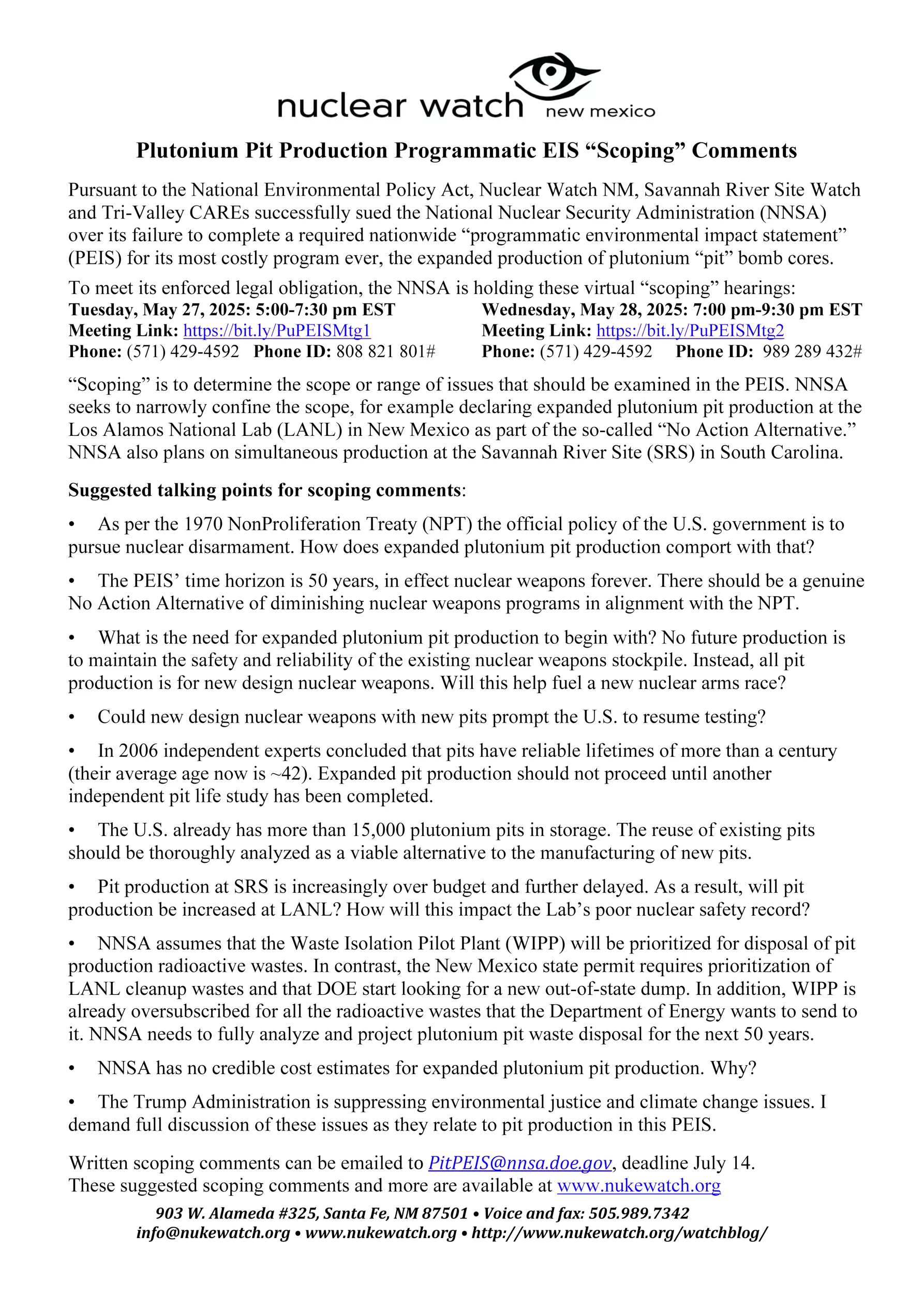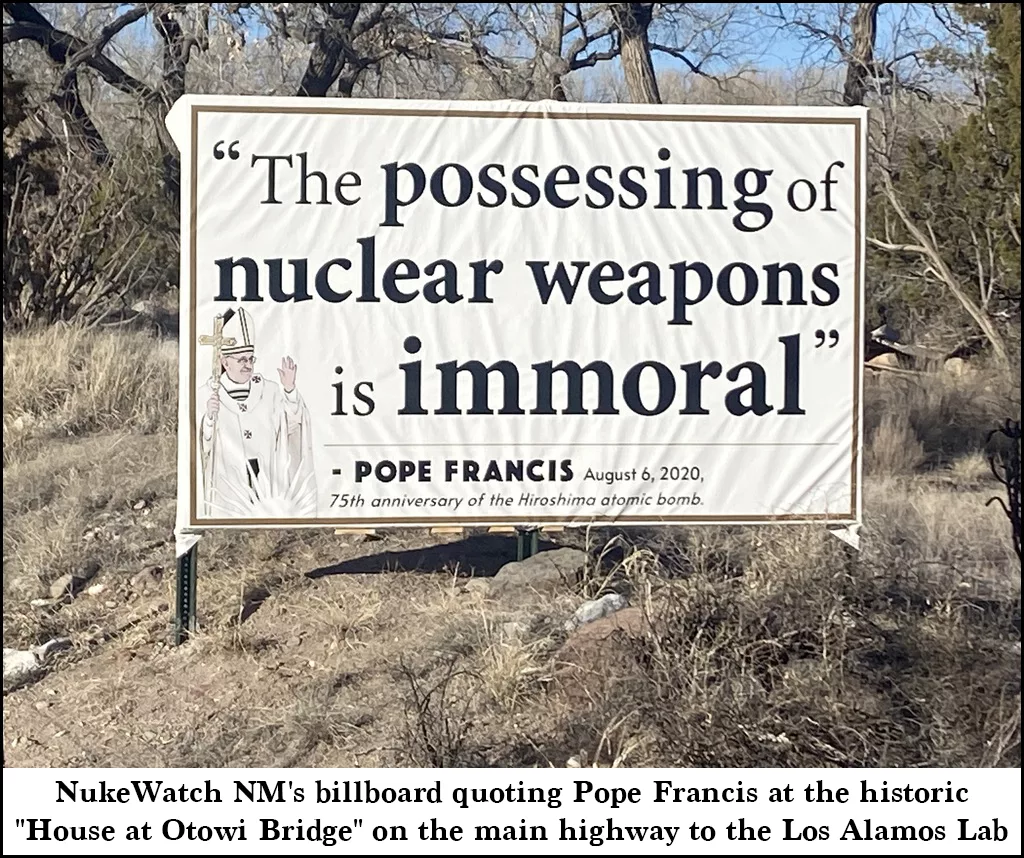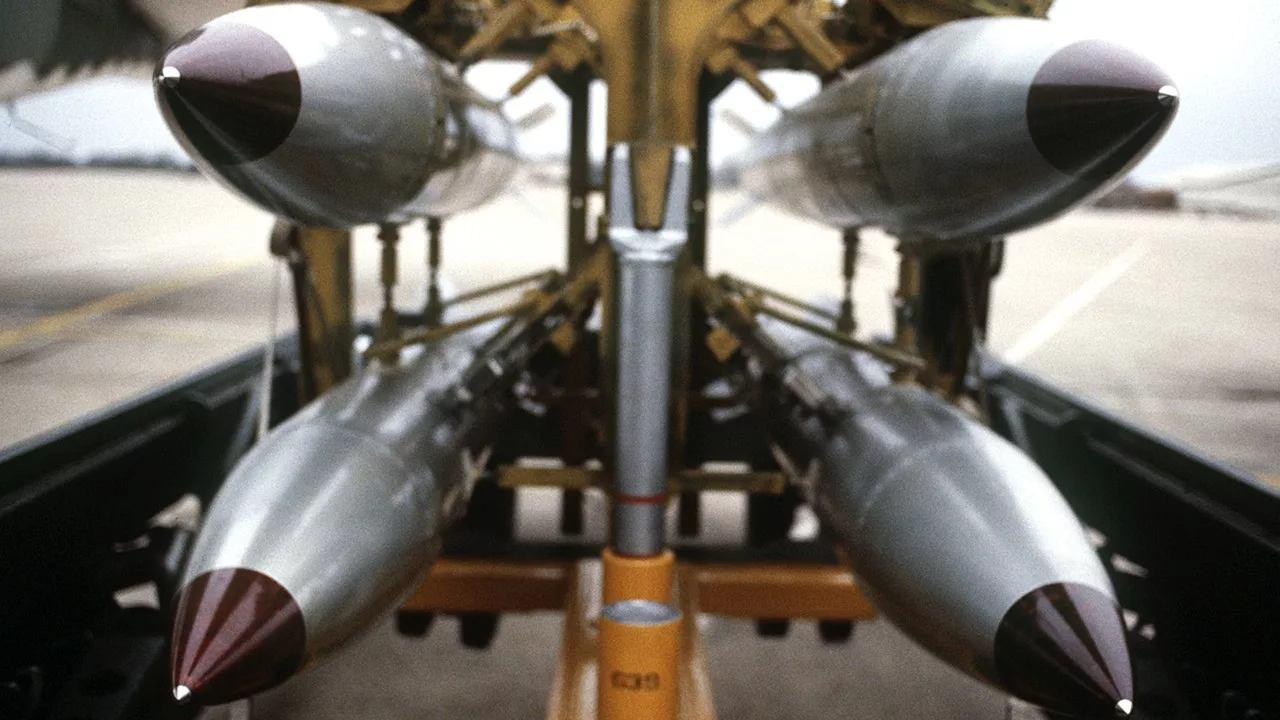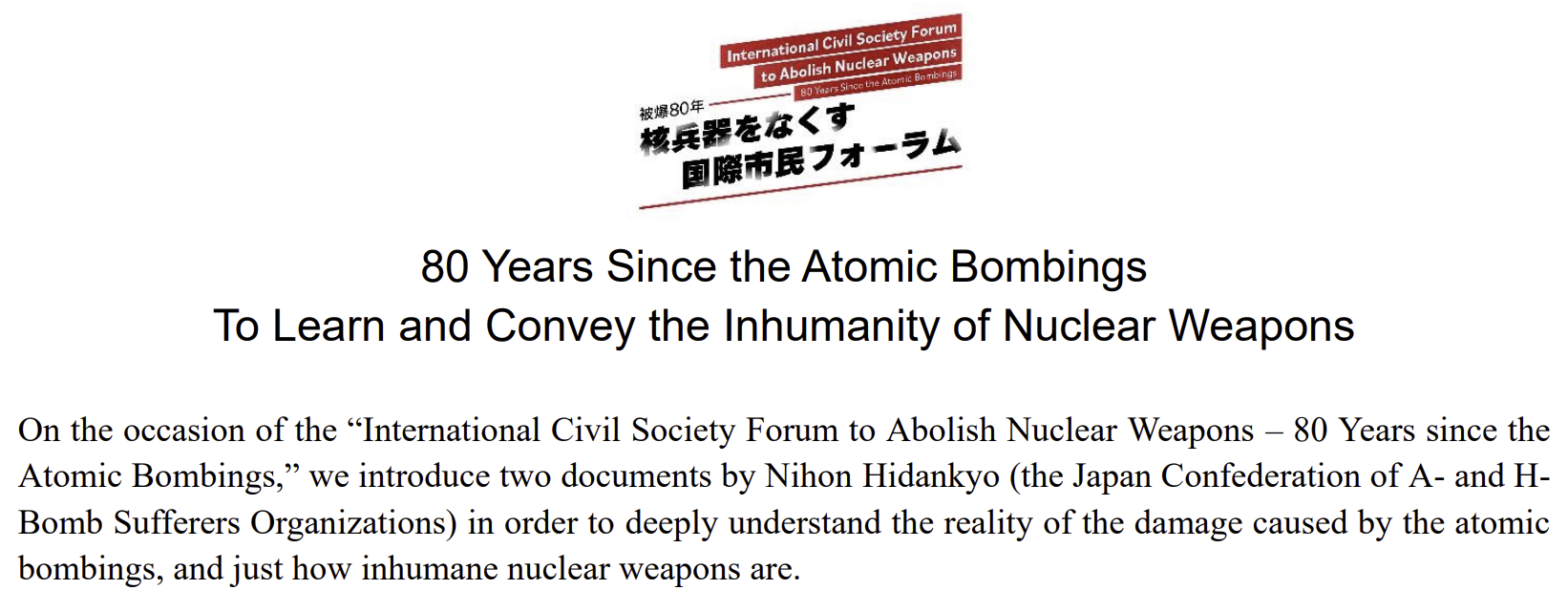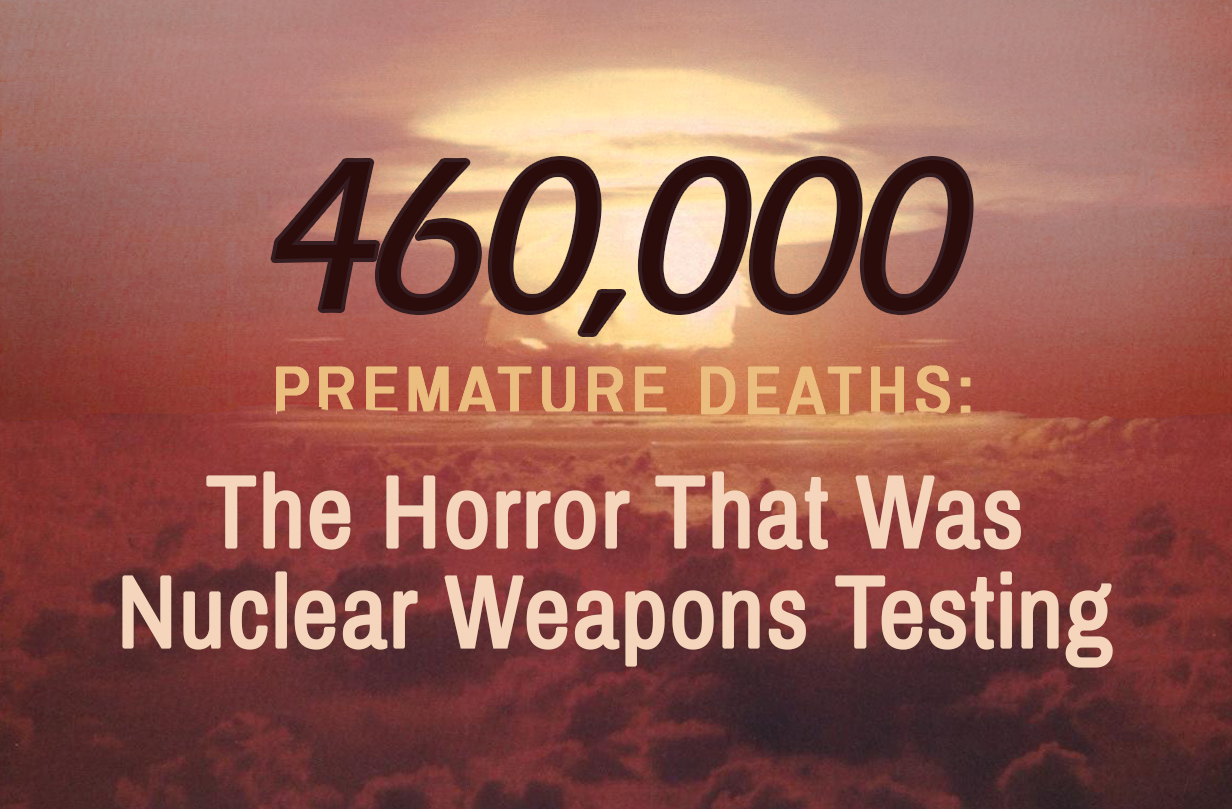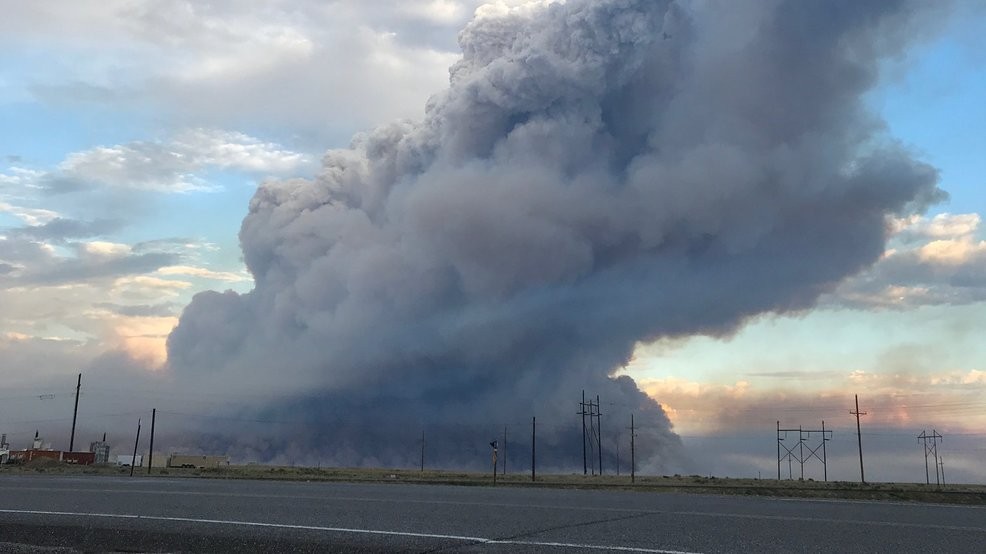Operation Crossroads: “The World’s First Nuclear Disaster”
“With Trump back in office, the recurring question of the need for nuclear weapons testing has resurfaced in the national security debate. Project 2025’s directive that the US return to ‘immediate test readiness’ raises further alarm, given the primacy of that document in Trump’s circle. The general uncertainty around current U.S. nuclear posture gives added weight to the historical importance of the atmospheric and underwater nuclear weapons tests conducted on the Bikini Atoll, recounted here by one of the leading advocates for public safety in the nuclear age. —Ed.”
By Robert Alvarez | Washington Spectator, National Security | May 29, 2025, washingtonspectator.com
Beginning in the late 1970’s, I was working for the Environmental Policy Institute around the time when atomic veterans started to descend on the nation’s capital. I would arrange meetings with Congressional offices, and the offices of both the Defense Nuclear Agency and Veterans Affairs, to enable the veterans to share their experiences and seek justice for being sent in harm’s way. About 250,000 soldiers, sailors, Marines, Coast Guard men, and airmen took part in atmospheric nuclear weapons tests from 1945 to 1963.
John Smitherman and Anthony Guarisco were 17- and 18-year-old sailors, respectively, in July of 1946, when they took part in “Operation Crossroads”—the first two nuclear weapons tests following World War II. These tests were conducted on the Bikini Atoll of the Marshall Islands and codenamed “Able” and “Baker.”
As a result of this extraordinary indifference to lethal danger, some 200 U.S. Navy ships were contaminated, and ships carrying radioactive fallout subsequently sailed to home ports in California. These ports are still being cleaned up today, nearly 80 years later. Glenn Seaborg, the chairman of the Atomic Energy Commission from 1961 to 1971, described the Baker test as “the world’s first nuclear disaster.”
Anthony and John were part of the U.S. Navy’s Pacific fleet involving 40,000 service men and 2,000 civilians. They along with others swam in the heavily contaminated Bikini Lagoon. When I met them in 1980, John was suffering from lymphatic cancer and Anthony from a severe form of spinal arthritis.
In March 1983, Anthony and his wife Mary showed up at my cluttered office and ceremoniously handed me a large stack of documents. They had just visited the UCLA library in Los Angeles and found boxes of forgotten, declassified documents belonging to Dr. Stafford Warren, the chief safety officer during both the Manhattan Project and the 1946 Crossroads tests.
Full Recording: First Scoping Hearing for NNSA’s Programmatic Environmental Impact Statement on Plutonium Pit Production
NEW Report on Plutonium Pit Production from the Union of Concerned Scientists
Today, UCS is releasing a comprehensive report on plutonium pit production. It includes a technical assessment of plutonium aging, a critical look at the weapons programs that new pits are slated for, and suggestions for alternatives, including pit re-use.
The final chapter of the study is on the human and environmental impacts of pit production and is intended as a tool for local advocacy groups to deepen their own work around issues such as the programmatic environmental impact survey that has just kicked off.
Links to the report:
https://www.ucs.org/resources/plutonium-pit-production
Spanish language executive summary:
https://es.ucs.org/recursos/la-produccion-de-nucleos-de-plutonio
Plutonium Pit PEIS Scoping Hearing Presentation: Slides and Recording
Get Prepared: A coalition of advocacy groups, including Union of Concerned Scientists, Tri-Valley CAREs, and NukeWatch New Mexico recently held a training to help participants prepare effective comments.
Watch the recording here
Password: gP=&0LYZ
Nuclear Weapons Issues & The Accelerating Arms Race: May 2025
Nuclear Weapons Budget:
• Republicans are pushing for $1 trillion per year for military spending. The fiscal 2026 budget request calls for $892.6 billion in discretionary defense funding — same as FY 2025 (and a cut given inflation). But they are also seeking $119.3 billion through budget “reconciliation.”
• Congressional Budget Office “Projected Costs of U.S. Nuclear Forces, 2025 to 2034,” April 2025:
“Costs of Current Plans: If carried out, DoD’s and DOE’s plans to operate, sustain, and modernize current nuclear forces and purchase new forces would cost a total of $946 billion over the 2025–2034 period, or an average of about $95 billion a year, CBO estimates… CBO’s current estimate of costs for the 2025–2034 period is 25 percent (or $190 billion) larger than its 2023 estimate of $756 billion, which covered the 2023–2032 period.” https://www.cbo.gov/system/files/2025-04/61224-NuclearForces.pdf
Separately it was reported that the twelve new Columbia class submarines will cost $12 billion each, three times more than their projected cost in 2010 and is years behind schedule.
Nuclear Weapons Update:
Nuclear weapons and delivery systems would get an added $12.9 billion in the new reconciliation proposal. This includes $2 billion for sea-launched nuclear cruise missiles and $400 million for their warhead.
Accelerating Arms Race
• The current conflict between India and Pakistan is dangerous.
• 4-4-25 ExchangeMonitor: https://www.exchangemonitor.com/wrap-up-russias-modern-arsenal-and-nukes-in-ukraine-deputy-secretary-of-energy-hearing-rubio-japan-and-rok-in-brussels-more/
“Russia’s top commander in Ukraine Gen. Sergei Surovikin discussed using nuclear weapons to prevent Ukraine from advancing into Crimea in the fall of 2022, the New York Times said March 29. The Times cited U.S. intelligence reports…”
Lawsuit Compels Nationwide Public Review of Plutonium Bomb Core Production
AIKEN, S.C. — Today the National Nuclear Security Administration (NNSA), the semi-autonomous nuclear weapons agency within the Department of Energy, published a formal Notice of Intent in the Federal Register to complete a nationwide “programmatic environmental impact statement” on the expanded production of plutonium “pit” bomb cores. Pits are the essential radioactive triggers of modern nuclear weapons. The NNSA is aggressively seeking their expanded production for new-design nuclear weapons for the new nuclear arms race.
The South Carolina Environmental Law Project (SCELP) successfully represented the Gullah/Geechee Sea Island Coalition and Nuclear Watch New Mexico, Savannah River Site Watch and Tri-Valley Communities Against a Radioactive Environment in a legal challenge to NNSA’s attempt to improperly jump start dual site pit production. On September 30, 2024, United States District Court Judge Mary Geiger Lewis ruled that the NNSA had violated the National Environmental Policy Act (NEPA) by failing to properly consider alternatives before proceeding with its plan to produce at least 30 pits per year at the Los Alamos National Laboratory (LANL) in New Mexico and at least 50 pits per year at the Savannah River Site (SRS) in South Carolina.
NNSA issues plans to assess pits environmental impact
“This programmatic environmental impact statement that we fought long and hard for empowers citizens to tell policy makers what they think about decisions being made in their name,” Jay Coghlan, from environmentalist group Nuclear Watch New Mexico, said Thursday in a press release by the plaintiffs of the case. “Let them know what you think about the $2 trillion ‘modernization’ program to keep nuclear weapons forever while domestic programs are gutted to pay for tax cuts for the rich.”
By ExchangeMonitor | May 9, 2025 exchangemonitor.com
On the heels of a federal judge’s ruling last fall, the Department of Energy’s National Nuclear Security Administration formally announced plans Friday for a detailed review of environmental impacts of planned plutonium pit production.
DOE’s semi-autonomous National Nuclear Security Administration (NNSA) announced in the Federal Register it is kicking off a programmatic environmental impact statement EIS to ensure that large-scale pit production will comply with the National Environmental Policy Act (NEPA).
According to the Federal Register notice, NNSA will hold public meetings and public hearings as part of the process.
Two online public scoping meetings are now scheduled for May 27 and May 28. The May 27 session would commence at 5 p.m. Eastern Time while the May 28 one is scheduled to start at 7 p.m. Eastern. Both can be accessed online or by phone. Details can be found in the Federal Register notice.
A federal district judge ruled last September that DOE and NNSA did not adequately analyze the environmental effects of producing the radioactive cores that trigger nuclear weapons in two different states, but declined to put the pit program, including construction of the Savannah River Plutonium Processing Facility at Aiken, S.C.’s Savannah River Site on hold as a result. In January, the federal government and the plaintiffs, consisting of environmentalists, settled the lawsuit and agreed to leave Los Alamos National Laboratory as the sole pit factory until NNSA completes a nationwide, NEPA-compliant programmatic EIS.Continue reading
US nuclear firm ‘utterly crucial’ to national security expands East Tennessee operations
“Which company produces uranium fuel for U.S. Navy nuclear reactors and manages the only plant where the government disassembles atomic warheads? What about the company helping NASA to develop a nuclear rocket, all while building small modular reactors and developing a pilot plant to restart uranium enrichment for the military?”
By Daniel Dassow, Knoxville News Sentinel | May 5, 2025 newsbreak.com
It’s all the same answer: BWX Technologies , the $2.7 billion juggernaut better known as BWXT has embedded itself in every kind of nuclear project imaginable with a strong and growing presence in East Tennessee, where 1,100 employees at its Nuclear Fuel Services plant in Erwin “downblend” bomb-grade uranium. The facility also creates fuel for the nuclear reactors aboard U.S. Navy submarines and aircraft carriers.
The region is even more important to BWXT after it bought a specialized facility in Jonesborough and 97 acres in Oak Ridge for a centrifuge enrichment project the company says will create hundreds of jobs through millions of dollars in investments.
“We have availed ourselves as a key player in just about every interesting nuclear opportunity that you can think of,” BWXT President and CEO Rex Geveden told Knox News. “We’re all over it.”
BWXT is part of the team led by the Tennessee Valley Authority to build the first small modular nuclear reactors in the U.S. at the federal utility’s Clinch River Nuclear Site in Oak Ridge .
It will manufacture the reactor pressure vessel, the largest component of the 300-megawatt reactor designed by GE Hitachi Nuclear Energy , for small modular reactors in the U.S. and Canada.
Curb the Skyrocketing Cost of U.S. Nuclear Modernization
“Since Russia and the United States agreed 15 years ago to modest nuclear reductions under the New Strategic Arms Reduction Treaty (New START), they also have embarked on extraordinarily expensive campaigns to replace and modernize every component of their respective nuclear arsenals to maintain force levels and provide the option to build up.”
By Daryl G. Kimball, Arms Control Today | May 1, 2025 newsbreak.com
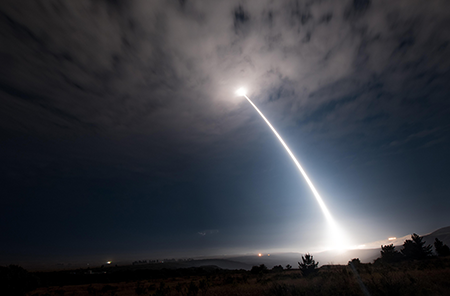
At the same time, their leaders have failed to resolve disputes about existing treaties or launch new negotiations to limit or further cut their deadly arsenals below the New START ceiling of 1,550 deployed nuclear warheads and 700 strategic missiles and bombers each.
In 2018, shortly after he withdrew the United States from the Intermediate-Range Nuclear Forces Treaty, U.S. President Donald Trump foolishly bragged about the nuclear stockpile that “until people come to their senses, we will build it up. It’s a threat to whoever you want, and it includes China, and it includes Russia, and it includes anybody else that wants to play that game.”
China has responded to U.S. nuclear and conventional military plans by pursuing a buildup of its historically “minimal” nuclear force to ensure that it retains an assured “second strike” capability. Russia has continued to develop new types of intermediate range missiles, as well as some new and exotic strategic systems designed to bypass U.S. missile defense capabilities.
Successive presidential administrations and congresses have failed to seriously consider alternatives that would have reduced costs and still maintained a devastating nuclear force.
Now, the cost of the U.S. nuclear modernization program is skyrocketing even further, siphoning resources from other more pressing human needs and national security priorities.
In April, the Congressional Budget Office issued its latest 10-year cost projection of the departments of Defense and Energy plans to operate, sustain, and modernize existing U.S. nuclear forces and purchase new forces: a total of $946 billion in the 2025-2034 period, or about $95 billion per year.
This new estimate is 25 percent, or $190 billion, greater than the last CBO estimate of $756 billion, which covered the 2023-2032 period. Incredibly, the $946 billion estimate does not include all of the likely cost growth of the new Sentinel intercontinental ballistic missile program, which the Pentagon acknowledged in July 2024 would cost 81 percent, or $63 billion, more than the program’s baseline estimate of $78 billion, generated in 2020.
Find Out the Facts & Sign the Petition: Why NMED Should Deny LANL’s Request for Tritium Releases
Why NMED Should Deny LANL’s Request for Tritium Releases
The Los Alamos National Laboratory plans to begin large releases of radioactive tritium gas any time after June 2, 2025. The only roadblock to the Lab’s plans is that it needs a “Temporary Authorization” from the New Mexico Environment Department to do so.
Reasons why NMED should deny LANL’s request are:
- The state Environment Department has a duty to protect the New Mexican As it states, “Our mission is to protect and restore the environment and to foster a healthy and prosperous New Mexico for present and future generations.” 1
- Why the rush? LANL explicitly admits there is no urgency. According to the Lab’s publicly-released “Questions and Answers” in response to “What is the urgency for this project?”
“There is no urgency for this project beyond the broader mission goals to reduce onsite waste liabilities.” 2
-
- In addition, the National Nuclear Security Administration (NNSA) admits that the end time frame for action is 2028, not 2025.3 Therefore, there is time for deliberate consideration.
- Contrary to NMED’s Resource Conservation and Recovery Act permit for LANL, the Lab has not fulfilled its duty to inform the public via NMED of possible alternatives to its planned tritium releases.4 According to Tewa Women United, “LANL has told EPA there are 53 alternatives; that list of alternatives, initially requested in 2022, has not yet been Tewa Women United has repeatedly asked LANL to provide the public with that list.” 5
University of New Mexico to host exhibit on nuclear history, technology, weapons
ALBUQUERQUE, N.M. (KRQE) — A provocative international exhibit will open soon at the University of New Mexico. “the bomb” is an immersive, multi-media installation exploring the history, technology, and threat of nuclear weapons.
By Nicole Sanders, KRQE | April 22, 2025 krqe.com
The installation includes an hour-long film projected on 45 screens conveying the hidden chaos and danger of the nuclear age. The experience is coming to UNM from April 30 to May 30. The full schedule at Zimmerman Library is available below:
- Wednesday, April 30
- Friday, May 2, 2025
- Friday, May 9, 2025
- Friday, May 16, 2025
- Friday, May 23, 2025
- Friday, May 30, 2025
Formal Comments on the Draft Site-Wide Environmental Impact Statement for Continued Operation of the Los Alamos National Laboratory
The National Environmental Policy Act requires the Los Alamos National Laboratory to periodically prepare a new “Site-Wide Environmental Impact Statement (SWEIS) for Continued Operations.”
Please use NukeWatch NM’s recent extensive comments on the Lab’s new draft SWEIS as a resource and citizens’ guide to Lab issues.
Did you know, for example, that:
• LANL’s nuclear weapons production budget has doubled over the last decade?
• The Lab’s so-called cleanup plan is to “cap and cover” some 200,000 cubic yards of radioactive and toxic waste, leaving them permanently buried as a perpetual threat to groundwater?
• There is a planned intentional release of up to 30,000 curies of radioactive tritium gas, all without a public hearing?
Use our lengthy formal comments as a starting point, toolkit or resource for dissecting ongoing and future issues at LANL!
We encourage you to use our comments to ask for follow-up info, either from us here at NukeWatch or from the Lab, and to demand better accountability and transparency! Use as background or briefing material for local and congressional advocacy.
For example:
- Cite or excerpt our comments in future public processes under the National Environmental Policy Act. For example, we are expecting that a nationwide programmatic environmental impact statement for plutonium “pit” bomb core production will be announced soon, the result of a lawsuit in which NukeWatch led.
- Share with those organizing around stopping expanded plutonium pit production and advocating for genuine radioactive and toxic wastes cleanup.
- Learn about LANL’s proposed electrical transmission line across the environmentally and culturally sensitive Caja del Rio and alternatives that were not considered.
- The National Environmental Policy Act itself is under assault by the Trump Administration. We expect environmental justice and climate change issues to be stripped from LANL’s final Site-Wide Environmental Impact Statement. This needs to be resisted!
NukeWatch NM argued that the draft SWEIS should be withdrawn and a new one issued because:
• The NNSA has rigged the draft LANL Site-Wide EIS with three self-serving scenarios:
– Expanded nuclear weapons programs (contradictorily called the “No Action Alternative”).
– Yet more expanded nuclear weapons programs (“Modernized Operations Alternative”).
– Yet far more expanded nuclear weapons programs (“Expanded Operations Alternative”).
• A Reduced Operations Alternative must be included.
• The SWEIS’ fundamental justification for expanded nuclear weapons programs is “deterrence.” But “deterrence” has always included nuclear warfighting capabilities that could end human civilization overnight.
• The SWEIS purports to align with U.S. obligations under the 1970 NonProliferation Treaty. That is demonstrably false.
• Future plutonium pit production is NOT to maintain the safety and reliability of the existing nuclear weapons stockpile. Instead, it is for new-design nuclear weapons that could lower confidence in stockpile reliability and/or prompt a return to testing.
• The SWEIS’ No-Action Alternative violates the National Environmental Policy Act (NEPA).
• The legally required programmatic environmental impact statement on pit production should be completed first, followed by the LANL SWEIS.
• Plutonium pit reuse should be analyzed as a credible alternative to pit production.
• A recent proposal for a data center at LANL is not in the SWEIS. It raises huge issues of future water and electrical use, the appropriateness of commercial interests at a federal lab, and the possible fusion of artificial intelligence and nuclear weapons command and control.
• Recent Executive Orders could strip the final SWEIS of environmental justice and climate change analyses. This must have clarification.
• Planned tritium releases should be fully analyzed.
• The Electrical Power Capacity Upgrade should be analyzed will all credible alternatives.
• The proposed BioSafety Level-3 facility must have its own standalone EIS.
• All Defense Nuclear Facilities Safety Board concerns should be addressed and resolved.
• Genuine comprehensive cleanup should be a preferred alternative.
• A new SWEIS should follow a new overdue Probabilistic Seismic Hazard Analysis.
Nuclear Weapons Issues & The Accelerating Arms Race: April 2025
Nuclear weapons
Air Force Weighs Keeping 1970s-Era Missiles Until 2050
The US Air Force is considering contingency plans that would extend the life of 1970s-era intercontinental ballistic missiles by 11 more years to 2050 if delays continue to plague the new Sentinel models intended to replace them. The current plan is to remove all 400 Minuteman III ICBMs made by Boeing Co. from silos by 2039… The Sentinel was projected last year to be deployed starting in May 2029. The first test flight was once projected for December 2023, but fiscal 2025 budget documents indicated a slip to February 2026.
The estimated cost of the new Sentinel intercontinental ballistic missiles (ICBM), originally at ~$110 billion, is now north of $180 billion. And this is before recognition of the immensity of supplying new command and control communications and recent consideration that its hardened silos may have to be replaced. IMHO it’s a propitious time to argue again for eliminating the land-based ICBM leg of the Triad. After all, one of its stated purposes is to act as a “nuclear sponge” for incoming Russian warheads. The odds of that are not zero and may increase if ICBMs are uploaded with multiple warheads after the New Strategic Arms Reduction Treaty expires in February 2026. More temptation for a preemptive first strike.
Calls to restart nuclear weapons tests stir dismay and debate among scientists
By Emily Conover, Science News | March 27, 2025 sciencenews.org
When the countdown hit zero on September 23, 1992, the desert surface puffed up into the air, as if a giant balloon had inflated it from below.
It wasn’t a balloon. Scientists had exploded a nuclear device hundreds of meters below the Nevada desert, equivalent to thousands of tons of TNT. The ensuing fireball reached pressures and temperatures well beyond those in Earth’s core. Within milliseconds of the detonation, shock waves rammed outward. The rock melted, vaporized and fractured, leaving behind a cavity oozing with liquid radioactive rock that puddled on the cavity’s floor.
As the temperature and pressure abated, rocks collapsed into the cavity. The desert surface slumped, forming a subsidence crater about 3 meters deep and wider than the length of a football field. Unknown to the scientists working on this test, named Divider, it would be the end of the line. Soon after, the United States halted nuclear testing.
Beginning with the first explosive test, known as Trinity, in 1945, more than 2,000 atomic blasts have rattled the globe. Today, that nuclear din has been largely silenced, thanks to the norms set by the Comprehensive Nuclear-Test-Ban Treaty, or CTBT, negotiated in the mid-1990s.
Only one nation — North Korea — has conducted a nuclear test this century. But researchers and policy makers are increasingly grappling with the possibility that the fragile quiet will soon be shattered.
Some in the United States have called for resuming testing, including a former national security adviser to President Donald Trump. Officials in the previous Trump administration considered testing, according to a 2020 Washington Post article. And there may be temptation in coming years. The United States is in the midst of a sweeping, decades-long overhaul of its aging nuclear arsenal…
Nuclear Nightmare: Meet America’s New B61-12 Gravity Bomb
What makes the B61-12 particularly impressive is the bomb’s ability to adjust its destructive yield depending on the operational conditions and demands.
By Stavros Atlamazoglou, National Interest | March 26, 2025 nationalinterest.org
Over the past months, the U.S. Air Force added another potent weapon to its arsenal: a new nuclear bomb, having recently completed production at Sandia National Laboratories in Albuquerque, New Mexico.
The B61-12 nuclear gravity bomb achieved full system production recently and is now fully operational. The nuclear bomb is one of the most versatile munitions of its type in the world, and a useful addition to the U.S. military’s nuclear deterrent capabilities.
The B61-12’s Unique Variable Yield Design
Sandia, one of the three main research and development laboratories for nuclear munitions, completed the production of the B61-12 nuclear gravity bomb. The nuclear munition is now fully operational.
What makes the B61-12 particularly impressive is the bomb’s ability to adjust its destructive yield depending on the operational conditions and demands. Put simply, the B61-12 is four bombs in one. The nuclear munition can be adjusted to four different yields—0.3, 1.5, 10, or 50 kilotons. The difference in yields means that the B61-12 has tactical, operational, and potentially even strategic utility.
Eight decades of nuclear threats are too much
Santa Fe New Mexican: My View John C. Wester
By John Wester, The Santa Fe New Mexican | March 15, 2025 santafenewmexican.com
I am John C. Wester, Archbishop of Santa Fe. I’m speaking on behalf of my archdiocese, and the archbishop of Seattle, the bishop of Hiroshima, and the archbishop of Nagasaki. We take guidance from our Holy Father, Pope Francis, who has declared the very possession of nuclear weapons to be immoral. We pray for his health.
Two years ago, in Nagasaki, on the 78th anniversary of its atomic bombing, we Catholic leaders formally created the Partnership for a World without Nuclear Weapons. Our four dioceses include the birthplace of nuclear weapons, the most deployed weapons in the United States, and the only two cities that to date have suffered atomic bombings. We lend our voices in staunch support of the Treaty on the Prohibition of Nuclear Weapons, at this Third Meeting of State Parties.
In July 2017, the Vatican was the first nation-state to sign and ratify the treaty. We note that the nuclear weapons powers have never honored their long-held obligations, under the 1970 Non-Proliferation Treaty, to enter into serious negotiations leading to global nuclear disarmament.
In contrast, the entry into force of the ban treaty was a great step toward the light of peace. The nuclear armed states have a moral obligation to hear the voices of the majority of the world, and to listen to those who are threatened by annihilation, at the whim of any one of their nine leaders.
The New York Times: DOGE Cuts Reach Key Nuclear Scientists, Bomb Engineers and Safety Experts
“Firings and buyouts hit the top-secret National Nuclear Security Administration amid a major effort to upgrade America’s nuclear arsenal. Critics say it shows the consequences of heedlessly cutting the federal work force.”
“The department has said that most of the fired employees handled administrative and clerical tasks that were not critical to the agency’s operation. But an analysis of the internal documents by The Times, coupled with interviews with 18 current and former agency officials, shows that is not true for the bulk of people who took the buyout,”
By Sharon LaFraniere, Minho Kim and Julie Tate, The New York Times | March 17, 2025 nytimes.com
…The Times reports that many had top-secret security clearance, giving them access to information on how nuclear weapons are made.
North Korea vows to ‘strengthen’ nuclear capabilities, rejecting G7 call for denuclearization
“The G7 called on Friday for North Korea to “abandon” its nuclear program.”
By Kevin Shalvey, ABC News | March 17, 2025 abcnews.go.com
LONDON — North Korea on Monday vowed to “steadily update and strengthen” its nuclear capabilities, a firm rejection of the G7’s call for Pyongyang to “abandon” its nuclear ambitions.
The country’s Foreign Ministry said that its “nuclear armed forces will exist forever as a powerful means of justice which defends the sovereignty of the state, territorial integrity and fundamental interests,” according to the Korean Central News Agency, a state-run media outlet.
How nuclear deterrence in Europe may change
“What does nuclear deterrence look like in Europe now that NATO is unsure whether the U.S. will be a committed partner? NPR speaks with Paul Cormarie, analyst with the Rand Corporation.”
By A Martínez, NPR | March 17, 2025 abcnews.go.com
Russia’s president, Vladimir Putin, says he supports a 30-day ceasefire with Ukraine in theory. But he adds that Ukraine would need to accept further conditions before a deal could be finalized. Now, in the interim, European leaders are discussing ways to discourage future Russian aggression. French President Emmanuel Macron has proposed using France’s nuclear capabilities as a deterrent to Russian threats. But what does nuclear deterrence look like in Europe if NATO is unsure if the U.S. will be a committed partner?
Hanford nuclear site subcontractor, owner to pay $1.1M for COVID loan fraud
“The money was intended to retain and maintain payroll for Hanford site workers assigned to the nuclear reservation in Eastern Washington and also a few Department of Veterans Affairs workers during the COVID-19 pandemic.”
“Within 48 hours of BNL receiving the Paycheck Protection Program loan at least $453,000 had been spent to pay off Stevenson’s personal and family debts, according to an indictment.
That included $100,000 transferred to Stevenson’s father and $48,600 to a family trust, according to court documents.
Much of the rest of the money was used to pay off credit card debt, according to the indictment.
The federal government later forgave the loan, which cleared it from having to be repaid.
BNL and Stevenson later applied for and received another Paycheck Protection Program loan of nearly $820,000.”
By Annette Cary, Tri-City Herald (Kennewick, Wash.) (TNS), The Columbian | March 12, 2025 columbian.com
Mar. 11—A former Hanford nuclear site subcontractor and its owner will pay a total settlement of just over $1.1 million to resolve accusations they defrauded the federal government through a COVID pandemic loan program.
On Wednesday, U.S. Judge Stanley Bastian in Yakima sentenced BNL Technical Services, owned by Wilson Pershing Stevenson III, to pay nearly $494,000 restitution to the federal government, as proposed in a settlement agreement.
That is in addition to $611,000 Stevenson, of Nashville, Tenn., already agreed to pay in a civil settlement to resolve his liability in the case.
Nuclear Watch New Mexico and Santa Fe Archbishop John C. Wester Attend the Third Meeting of States Parties to the Treaty on the Prohibition of Nuclear Weapons
We had the honor of joining the Archbishop of Santa Fe, John Wester, in attending the third Meeting of States Parties to the Treaty on the Prohibition of Nuclear Weapons last week, March 3-7 in New York City. The archbishop gave mass to several different groups (see photos below) and spoke at the UN headquarters as part of Civil Society.
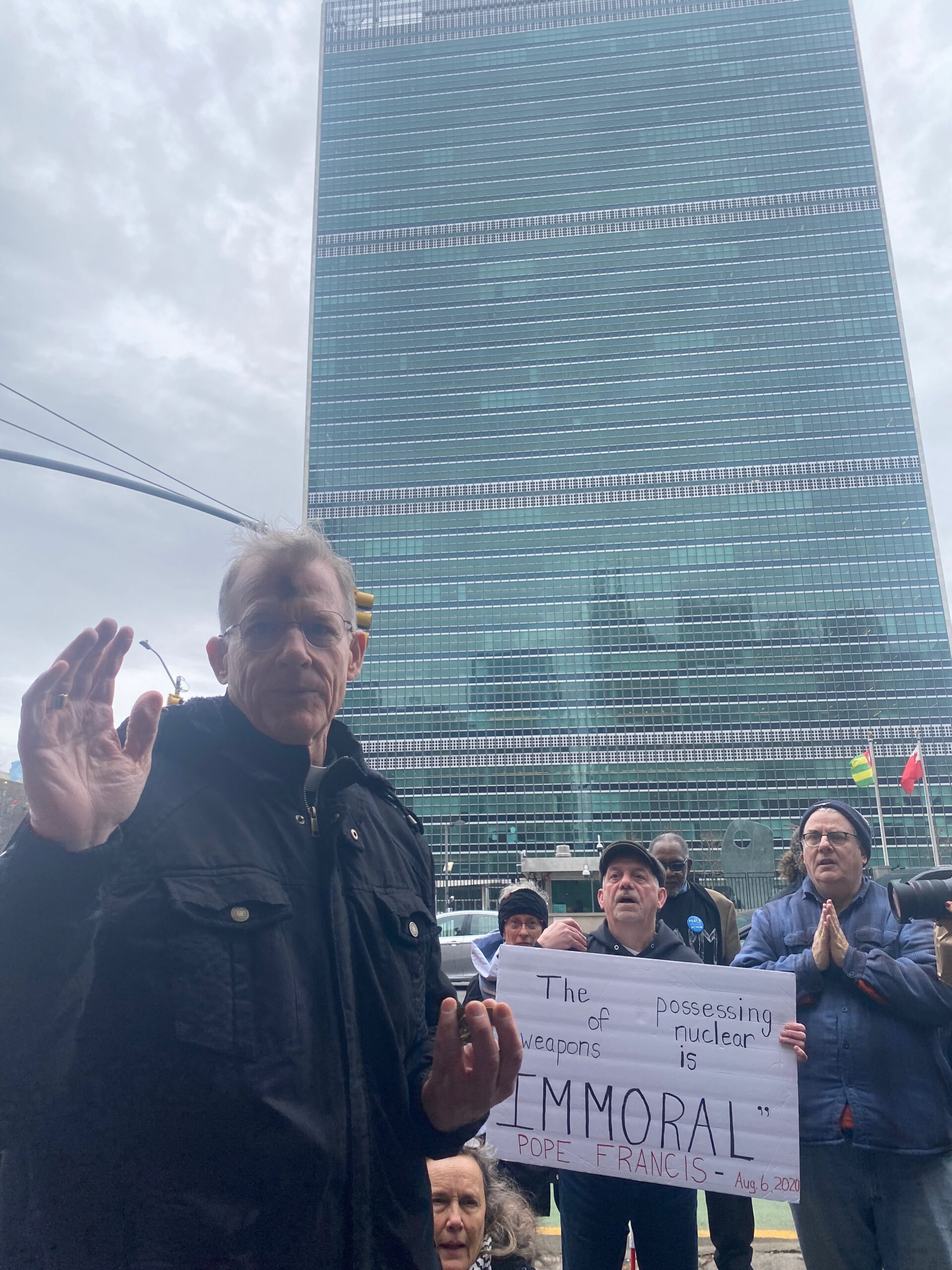
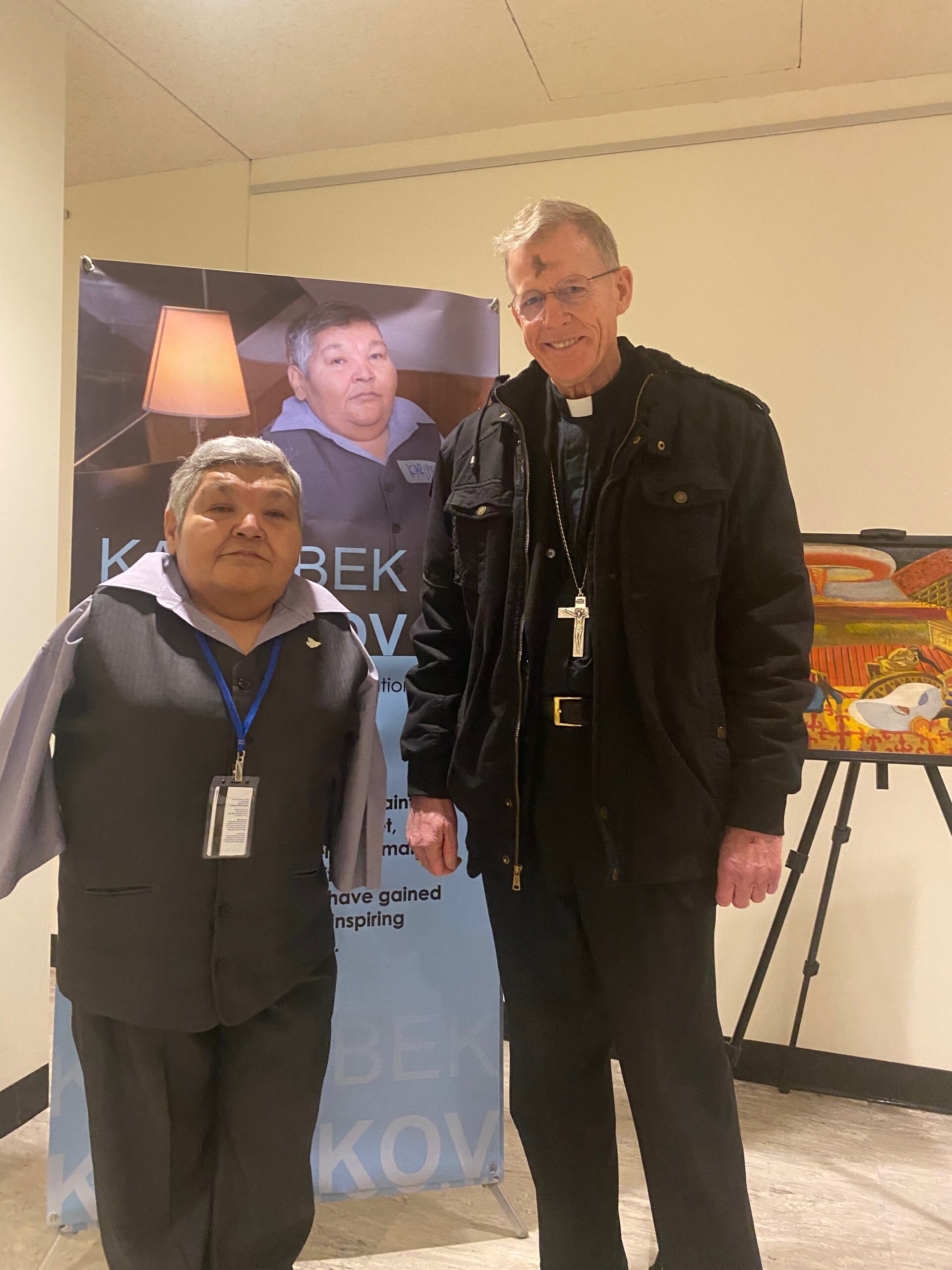
In New York City this week? Join Pax Christi members and friends at Mass with Archbishop John Wester (Santa Fe NM) on Tuesday, March 4, 6 pm, at the Church of Our Saviour, 59 Park Avenue at 38th Street. Use this link to RSVP. #TPNW #3MSP #nucleardisarmamentwww.dorothydayguild.org/WesterMass25
— Pax Christi USA (@paxchristiusa.bsky.social) 2025-03-03T16:35:50.942Z
Germany skips UN conference on banning nuclear weapons in New York
“Germany has decided not to take part in a UN conference in New York to review a landmark treaty on nuclear weapons prohibition.”
By dpa International | March 4, 2025 dpa-international.com
“The Treaty on the Prohibition of Nuclear Weapons dates back to a time before the Russian war of aggression against Ukraine,” the Foreign Office told dpa in Berlin on Tuesday. “The intention and ambition of the treaty no longer reflect the current reality in security policy.”
The treaty was signed in 2017 and came into force in 2021. There are currently 94 signatories and 73 states parties, according to the International Campaign to Abolish Nuclear Weapons (ICAN).
Germany does not possess nuclear weapons but is allied with three nuclear powers in NATO: the United States, France and the United Kingdom.
Berlin is not a signatory to the prohibition treaty, but it participated in previous conferences as observers.
Brief Analysis of Today’s U.S. Supreme Court Oral Arguments on the Illegality of Licensing Radwaste Dumps in TX and NM
Today the United States Supreme Court heard arguments in the case of the Nuclear Regulatory Commission vs. Texas. At issue is whether the NRC exceeded its authority when it approved licenses for proposed “consolidated interim storage facilities” for high-level radioactive waste, and this includes highly irradiated “spent” fuel from nuclear power plants.
Two consolidated interim storage facilities are planned for western Texas and southeastern New Mexico. The Nuclear Waste Policy Act of 1982, as Amended specifically prohibits private “interim” storage of federal spent nuclear fuel, and disallows the Department of Energy from taking title to the waste unless a permanent geologic repository is licensed, built and opened. The law intended to prevent private “interim” storage of federal radioactive waste because interim storage is much less robust than permanent storage, and would double the risk of accident or attack during transport, since consolidated “interim” storage means the waste has to be moved twice, once to the CISF and again to a permanent repository.
Broken arrows: The hidden secret behind America’s missing nuclear weapons
“Dedicated Navy divers, demolition teams, and high-powered sonar spent weeks searching the ocean floor and came up empty.”
By Kaif Shaikh, Interesting Engineering | March 3, 2025 interestingengineering.com
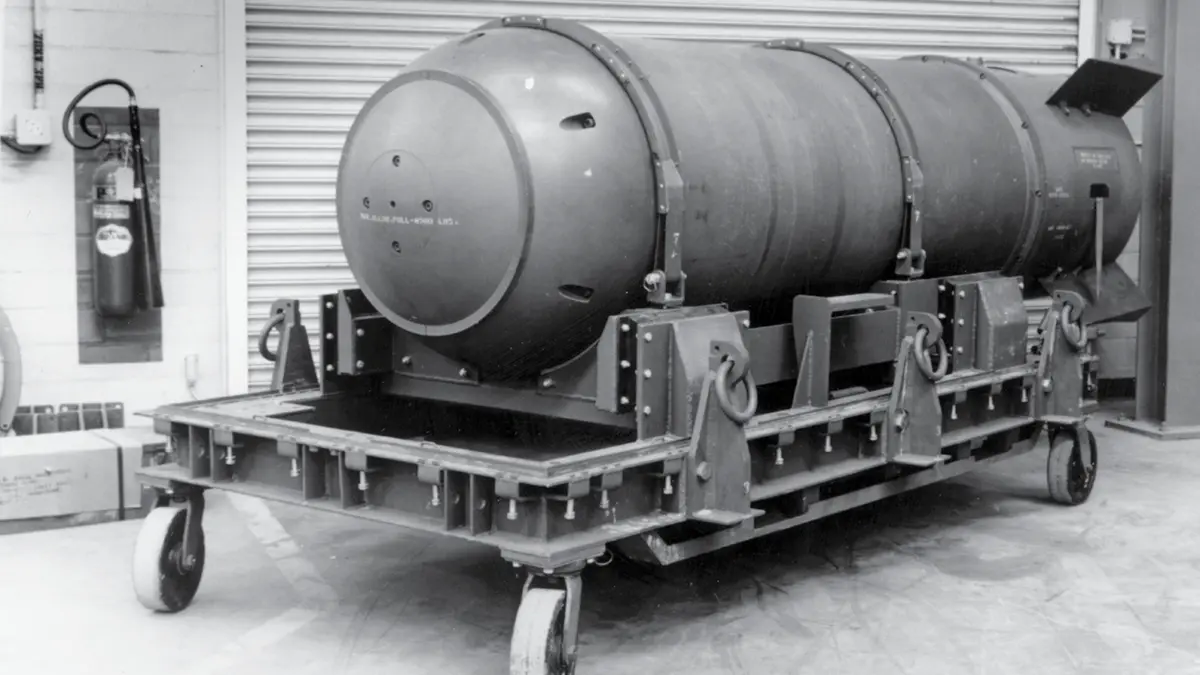
Throughout history, the idea of misplacing a nuclear weapon may sound like a plot twist in an espionage novel. The United States has experienced more than a handful of such incidents. Known as “Broken Arrows,” these events typically refer to any accidents involving nuclear weapons that do not pose an immediate risk of triggering a nuclear war.
For decades, details remained hidden behind top-secret clearances. However, unclassified records reveal that the U.S. military has had a surprising number of mishaps, with some bombs still unaccounted for to this day.
What are broken arrows?
The Department of Defense defines a “Broken Arrow” as any incident involving a U.S. nuclear weapon or warhead that results in accidental launching, firing, detonating, theft, or loss of the weapon. From 1950 to 1980, official sources cite 32 Broken Arrow incidents, but there may have been more, given the secrecy surrounding nuclear matters.
Christie Brinkley: Don’t let the US resume nuclear weapon tests that ended decades ago
“The United States and other nuclear powers are now moving closer to resuming nuclear weapons tests, decades after testing ended. This highly disturbing trend must be halted.”
By Christie Brinkley Special to The Kansas City Star Miami Herald | March 3, 2025 miamiherald.com
Since the atomic age, 2,056 nuclear weapons have been detonated, 528 of them above the ground. The United States and Soviet Union accounted for about 85% of these tests. The explosive power of atmospheric tests equaled 29,000 Hiroshima bombs. Airborne radioactive fallout circled the globe, re-entered the environment through precipitation, and entered human bodies through food and water.
Cold War bomb testing was part of a massive increase in the number of nuclear weapons, which peaked at more than 60,000. After nuclear war was barely avoided during the Cuban missile crisis, public pressure convinced leaders to ban all above-ground tests in 1963 — a treaty that has never been violated.
The test ban treaty was a huge achievement for peace, beginning eased tensions between nuclear nations. It also was a landmark for public health. A study by St. Louis residents and scientists found an enormous buildup of radioactive strontium-90 levels in baby teeth — 63 times higher in children born in 1963 compared to those born in 1950.
LISTEN LIVE TO U.S. SUPREME COURT ORAL ARGUMENTS ON THE ILLEGALITY OF LICENSING RADWASTE DUMPS IN TX AND NM
“The case pits the nuclear industry’s push for CISFs against the interests of fossil fuel companies which object to high-level radioactive waste dumped in their drilling/fracking areas, the state governments of Texas and New Mexico, which have passed laws prohibiting importation of nuclear waste to their states, and cities along the transport routes which object to it being shipped through their jurisdictions. Their amicus briefs in the case are posted here.”
For immediate release
MEDIA ALERT for Wednesday, March 5, 2025
WASHINGTON, D.C.,
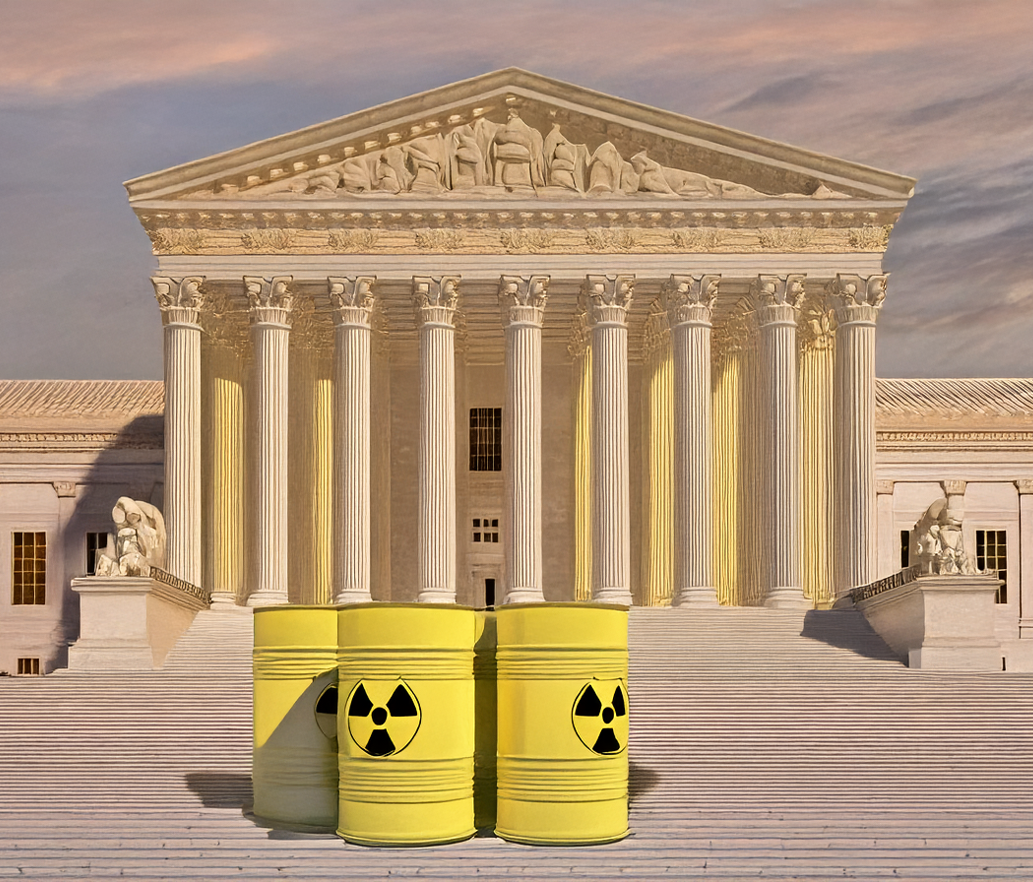 WHAT? Wednesday morning, March 5, the United States Supreme Court will hear oral arguments in Nuclear Regulatory Commission vs. Texas. At issue in the SCOTUS (Supreme Court of the U.S.) proceeding is whether the NRC exceeded its authority when it approved licenses for proposed “consolidated interim storage facilities” for high-level radioactive waste including highly irradiated “spent” fuel from nuclear power plants. Two CISFs are planned for western Texas and southeastern New Mexico. The Nuclear Waste Policy Act of 1982, as Amended specifically prohibits private “interim” storage of federal spent nuclear fuel, and disallows the Department of Energy from taking title to the waste (which would be necessary for DOE to transport it to CISFs), unless and until a permanent geologic repository is licensed, built and opened to receive the waste. The law intended to prevent private “interim” storage of federal radwaste, which is much less robust than permanent storage, and would double the risk of accident or attack during transport, since consolidated “interim” storage necessitates moving the waste twice, once to the CISF and again to a permanent repository. The NRC approved recent CISF license applications despite the law, saying it anticipated Congress would change it in the future. But the federal Fifth Circuit court ruled that the NRC didn’t have that authority. If the Supreme Court strikes that ruling down, it could open the floodgates for thousands of shipments of spent fuel from nuclear power plants across the US, through many states, to CISFs in Texas and New Mexico.
WHAT? Wednesday morning, March 5, the United States Supreme Court will hear oral arguments in Nuclear Regulatory Commission vs. Texas. At issue in the SCOTUS (Supreme Court of the U.S.) proceeding is whether the NRC exceeded its authority when it approved licenses for proposed “consolidated interim storage facilities” for high-level radioactive waste including highly irradiated “spent” fuel from nuclear power plants. Two CISFs are planned for western Texas and southeastern New Mexico. The Nuclear Waste Policy Act of 1982, as Amended specifically prohibits private “interim” storage of federal spent nuclear fuel, and disallows the Department of Energy from taking title to the waste (which would be necessary for DOE to transport it to CISFs), unless and until a permanent geologic repository is licensed, built and opened to receive the waste. The law intended to prevent private “interim” storage of federal radwaste, which is much less robust than permanent storage, and would double the risk of accident or attack during transport, since consolidated “interim” storage necessitates moving the waste twice, once to the CISF and again to a permanent repository. The NRC approved recent CISF license applications despite the law, saying it anticipated Congress would change it in the future. But the federal Fifth Circuit court ruled that the NRC didn’t have that authority. If the Supreme Court strikes that ruling down, it could open the floodgates for thousands of shipments of spent fuel from nuclear power plants across the US, through many states, to CISFs in Texas and New Mexico.
Expanded Plutonium “Pit” Bomb Production is Immoral – Spend Nuclear Weapons “Modernization” Money Ethically ELSEWHERE
Why the nation’s nuclear waste may eventually be headed to northwest Colorado
Nuclear waste is piling up at power plants around the country, and we have no idea where to put it. Many states are aggressively fighting plans for new storage facilities.
But northwest Colorado is quietly opening the door.
By In The NoCo, Scott Franz, Erin O’Toole, Brad Turner | February 22, 2025 kunc.org
KUNC’s investigative reporter Scott Franz recently traveled around rural Colorado talking with people about what nuclear waste storage could do for the local economy – and also interviewing folks who are dead set against that idea.
On this special edition of In The NoCo, we’ve combined all of Scott’s reporting from the past few months into a single episode. You can also see photos and check out more on this investigation.

Arms Control Association – Trump Regains Control Over Nuclear Policy: What’s Next?
It has been barely a month since Inauguration day, but it is apparent that Donald Trump is determined to reshape U.S. foreign policy, radically alter alliance relationships, and upend Washington’s approach toward key adversaries, like Russia, in ways that are not yet clear.
Arms Control Association | February 21, 2025 armscontrol.org
And here at home, Trump’s brash assertion of executive power is putting our nation’s democratic institutions and the rule of domestic law at risk, in part by altering or dismantling key government departments,agencies and functions, all without congressional approval.
All of this makes our mission to provide reliable information and sound policy solutions even more important and difficult.
The Arms Control Association has a clear and focused strategy to reduce the dangers posed by nuclear weapons and other WMD. Many of these priorities are outlined in this ACA-organized January 28 communication to all members of Congress that was endorsed by 16 of our partner organizations and leaders.
Like many others, however, we are still sorting out how to adjust to and contend with the post-Inauguration political dynamics.
But we must and we will, because critical, weapons-related security decisions lie ahead:
- So long as Russia’s assault on Ukraine continues, there is still a heightened risk of nuclear weapons use, and there are narrowing prospects for a deal to maintain limits on the U.S. and Russian nuclear arsenals after New START expires in one year.
- Although Trump has decried exorbitant military expenditures, the authors of Project 2025, the 920-page manifesto crafted by the Heritage Foundation and others, want the United States to spend even more than the current $756 billion ten-year price tag for nuclear modernization in order to increase the size and diversity of the U.S. arsenal. China and Russia are watching and will surely respond to any U.S. nuclear buildup.
- Project 2025 also calls for preparing to resume U.S. nuclear explosive testing for the first time since 1992. Should the United States do so, it would open the door to nuclear testing by other states, unravel the CTBT, and blow apart the global nonproliferation system at a time of increasing nuclear danger.
- Since Trump withdrew from the 2015 Iran nuclear deal, Tehran has expanded its capacity to produce weapons-grade nuclear material and reduced international inspectors’ access. Trump says he wants a nuclear deal; Iran’s president says he wants a nuclear deal. But time is short. Without a deal to scale back tensions and Iran’s nuclear capacity, we could see renewed international sanctions by October, Iranian withdrawal from the NPT, and/or an attempt by Israel to bomb Iran’s nuclear sites.
How exactly the second Trump administration and the new Congress will try to navigate all these nuclear-related challenges ahead is not yet clear — but if Project 2025 becomes the blueprint for U.S. nuclear weapons policy, we are in big trouble.
But, it may also be possible to steer us toward a safer course.
Trump wants to initiate denuclearization talks with Russia and China
On Thursday, President Donald Trump signaled that he wants to engage with Russia and China on denuclearization efforts.
By Erik English, BULLETIN OF ATOMIC SCIENTISTS | February 14, 2025 thebulletin.org
“There’s no reason for us to be building brand new nuclear weapons. We already have so many,” Trump said from the White House.
“You could destroy the world 50 times over, 100 times over. And here we are building new nuclear weapons, and they’re building nuclear weapons, and China’s building nuclear weapons.” The number of nuclear weapons the United States and Russia can have is established by New START, which expires in 2026. Without a new agreement, nuclear states could begin to build up their arsenals for the first time since the Cold War. “Hopefully, there’ll never be a time when we need those weapons,” Trump said. “That’s going to be a very sad day, that’s going to be probably oblivion.”
Share Your Experiences at Los Alamos National Laboratory
The New York Times would like to hear from you about workplace protocols and safety measures at LANL.
By Alicia Inez Guzmán | Alicia Inez Guzmán is reporting on the nuclear industry in New Mexico as part of The Times’s Local Investigations Fellowship – THE NEW YORK TIMES February 11, 2025 nytimes.com
More voices, better journalism. The questionnaire you are reading is just one tool we use to help ensure our work reflects the world we cover. By inviting readers to share their experiences, we get a wide range of views that often lead to a more deeply reported article. We make every effort to contact you before publishing any part of your submission, and your information is secure. Here’s more on how it works and why it’s good for us and you.
The Los Alamos National Laboratory (LANL) has recently embarked on the “new Manhattan Project” — a hiring spree and multibillion dollar expansion to build plutonium bomb cores for nuclear weapons.
The Times is writing about this new mission and how the lab is keeping workers safe, reporting accidents and environmental contamination and making needed upgrades to key facilities, including in Technical Area 55, the heart of bomb core production.
Have you or someone you know worked at TA-55 or another “hot site” and experienced a workplace accident or been exposed to plutonium, beryllium or another radioactive or toxic substance on the job? What safety measures were in place? Were there follow-up health assessments?
Please answer the questions using the form:
LANL Site-Wide EIS Hearings in Santa Fe and Los Alamos Filled with Loud Protest and Vehement Dissent: Nuclear Weapons are IMMORAL
In this Site-Wide EIS we’re given three options: Expanded nuclear weapons programs (hypocritically called the no action alternative), then we’re presented with yet more expanded nuclear weapons programs, and the third alternative is even more expanded nuclear weapons programs. What we really need is a genuine alternative in this Site-Wide, and I hope that citizens will repeatedly bring this up. We need a TRUE ALTERNATIVE in which the US begins to show global leadership towards nuclear disarmament that it promised to in the Non-Proliferation Treaty, and that should be reflected in the sitewide which shows just passive maintenance of the stockpile. We don’t need Pit Production because it’s for NEW designs – NOT to ensure the safety and reliability of the existing stockpile. The US, for our own national security and global security, we need to lead the world towards global nuclear disarmament – and this Site-Wide EIS does the opposite.
The hearings in Santa Fe and Los Alamos on February 11 and February 13, 2025, respectively, both had virtual participation options. The attendees online and in person were equally vehement in protesting the “rigged game” we’re given with this SWEIS and decrying the fact that there is no alternative besides increased nuclear weapons production.
And read an exceprt from the Archbishop of Santa Fe, John Wester’s comments:
“As we all know, we’re in an accelerating new nuclear arms race that’s made even more dangerous because of artificial intelligence, multiple nuclear actors and hypersonic delivery systems. It’s an already scary situation that has become even scarier, and what concerns me is that Los Alamos and Santa Fe play a key role in naturally fostering and promoting this new nuclear arms race – a race which I believe is an affront to all that is good and holy, all from our perspective that God has placed in us to live in harmony with one another. Nuclear weapons pose one of the greatest threats to that harmony. I think it’s important to know what I’m learning more and more about is that expanded plutonium pit production is not simply to maintain the safety and reliability of our existing so-called deterrence. I think it’s important that people are aware that it’s really for new design nuclear weapons for this new particular armed race. I think it’s important that that people recognize that deterrence is not the way to go. In that light, I would say obviously for me is a Catholic Bishop, Pope Francis I think has really changed the whole moral landscape of looking at nuclear weapons. On the 70th anniversary of the Hiroshima atomic bombing, Pope Francis declared that the very possession of nuclear weapons is immoral. As Catholics this was an extremely important shift there. The 1983 United states conference of Catholic Bishops did allow for deterrence – it was promoting disarmament but made caveats for deterrence. But Pope Francis has taken that off the table in saying that even possessing nuclear weapons is immoral, it’s unethical. One of the main reasons for this church’s shift on this was that the nuclear weapons powers really have failed in their pledge in 1970 when they joined the Non-Proliferation Treaty. The TPNW came about because of that failure, and so it seems to me then based on what Pope Francis said, that if possessing nuclear weapons is immoral, then expanding plutonium pit cores and modernizing our weapons systems in order to be more involved in the new nuclear arms race is also immoral. This policy is unethical. Now I want to be careful here, I am not saying that anyone working at Los Alamos or Sandia or Lawrence Livermore in California, I’m not judging them or saying there are immoral – that’s a different matter in one’s conscience. I’m saying that the policy is involved and the Pope said that nuclear weapons themselves are intrinsically immoral. I think that’s an important thing to keep in mind, that that we need to be moving toward disarmament and that if we’re not, if that’s not our trajectory, rather if it’s just to build up our defenses, then that’s an immoral buildup.”
Gearing Up for the Public Hearings on the LANL Draft Sitewide Environmental Impact Statement: Pit Production at LANL
“Nuclear Watch New Mexico hosted a workshop on February 6 on the newly released Draft Sitewide Environmental Impact Statement (SWEIS) for Los Alamos National Laboratory (LANL) to present information and elicit discussion on this NEPA process that Jay Coghlan, executive director of Nuke Watch, referred to as a “rigged game” at the beginning of the workshop. What that means will become evident as I review the part of the workshop I attended.”
By Kay Matthews, La Jicarita | February 7, 2025 lajicarita.wordpress.com
Archbishop John Wester, an outspoken critic of nuclear weapons proliferation under the guise of nuclear deterrence instead of disarmament spoke briefly to open the discussion. Quoting Pope Francis, he said, “possessing nuclear weapons is immoral.” He then said, “Pit production is immoral.” His only qualification is that it’s the policy that’s immoral, not the people who promote it. We’ve failed to uphold already existing treaties and failed to implement new ones. He’ll be going to the United Nations in March for a meeting, Treaty on the Non-Proliferation of Nuclear Weapons, and to Japan in August to meet with his partners in the World Without Nuclear Weapons.
Coghlan explained that next week the Department of Energy (DOE) and the semi-autonomous National Nuclear Security Administration (NNSA) will hold public hearings, as required by NEPA, on the LANL SWEIS, in Santa Fe, Española, and Los Alamos. He cautioned that while we should all be “cynical” about the process, we need to go ahead and protest the fact that all three alternatives provided in the SWEIS expand pit production, just at different amounts. The process is rigged because the DOE and NNSA failed to update a 2008 Environmental Impact Statement before pit production began at LANL (the other nuclear facility, the Savannah River Site in South Carolina, is slated to produce 50 pits a year but is completely unprepared for pit production).
The guest speaker was Dylan Spaulding, Senior Scientist for the Union of Concerned Scientists…
NukeWatch Los Alamos Lab Site-Wide EIS Workshop – February 6, 2025
Full Video Recording: NukeWatch Los Alamos Lab Site-Wide EIS Workshop |
NukeWatch Presentation: Los Alamos Lab Site-Wide EIS Workshop |
|---|---|
|
NukeWatch Los Alamos Lab Site-Wide EIS Workshop |
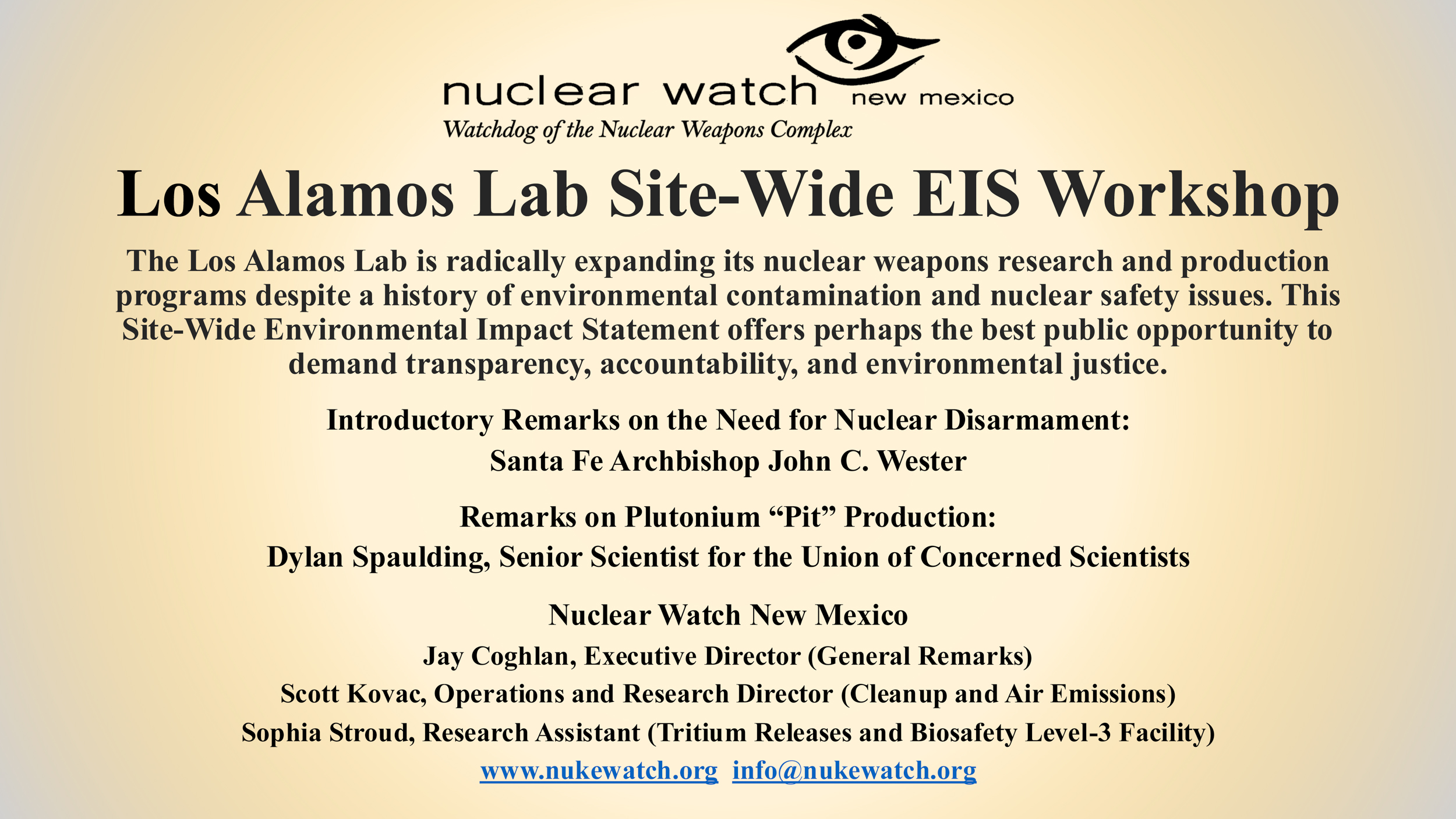 |
In Memoriam: Ken Mayers
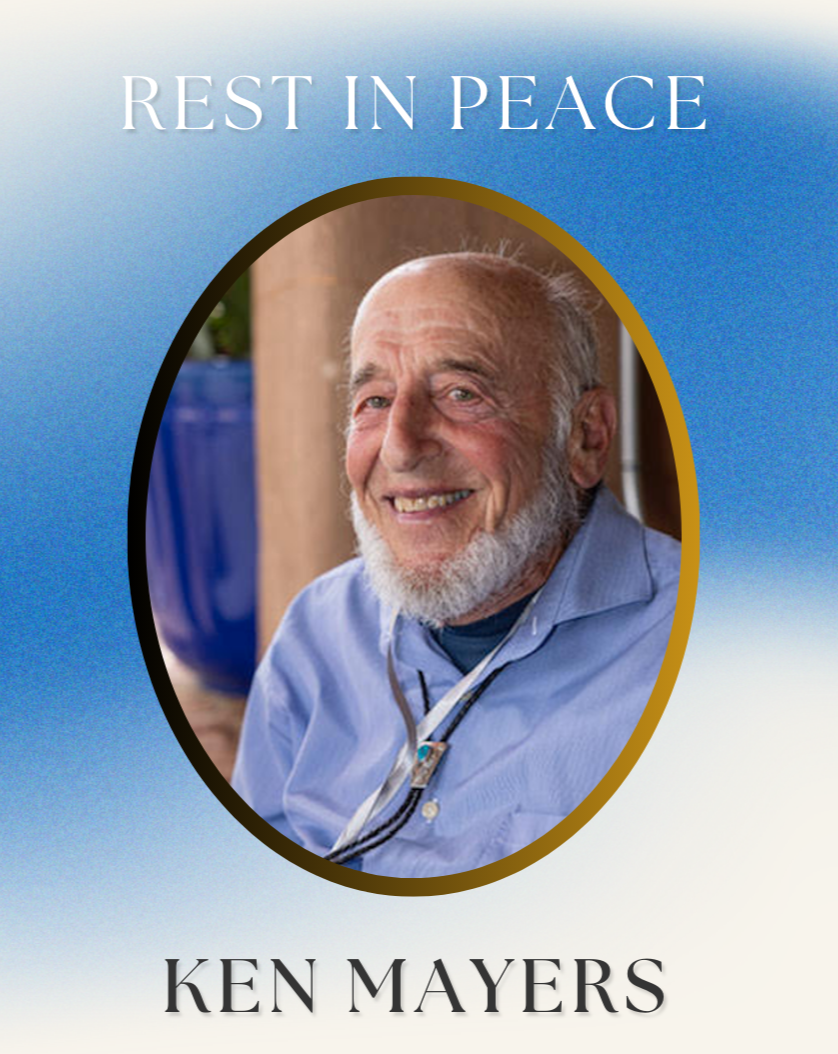 We here at NukeWatch will dearly miss Ken’s weekly presence at the corner vigil to protest Nuclear Weapons in Santa Fe.
We here at NukeWatch will dearly miss Ken’s weekly presence at the corner vigil to protest Nuclear Weapons in Santa Fe.
Locally, Ken was co-founder of the Santa Fe Chapter of Veterans for Peace and an active member of Santa Feans for Justice in Palestine. Ken worked with the local chapter of US Combatants for Peace and the Justice Council of the Unitarian Universalist Congregation in Santa Fe where he was also an enthusiastic baritone and co-founder of the NM Peace Choir.
A Celebration of Ken’s life will be held Friday, April 4 beginning at 12 noon at the corner of Sandoval and West Alameda, (Santa Fe’s weekly vigil to protest Nuclear Weapons), followed by lunch and a hybrid service at the UU Congregation, 107 West Barcelona Street, Santa Fe, NM.
For those wanting to pay tribute to Ken, please consider planting a tree through A Living Tribute (https://shop.alivingtribute.org/) or make a donation in his memory to the Santa Fe Joan Duffy Chapter of Veterans for Peace https://www.vfp-santafe.org/
Ken was a lifelong, passionate defender of peace. Read more:
Los Alamos’ plutonium pit production of 30 annually for Sentinel may have to wait beyond 2026
As the Department of Energy’s National Nuclear Security Administration awaits its marching orders from the President Donald Trump (R) administration, the Los Alamos National Laboratory is now saying it will get to an annual plutonium pit production goal of 30 “ASAP.”
Exchange Monitor | January 31, 2025 counterpunch.com
Such pits are the triggers for thermonuclear weapons…
Nuclear News Archive – 2022
Native American tribe claims nuclear waste can’t be stored on its land
To the Western Shoshone, most of Nevada isn’t Nevada. At least not in the current sense.
BY JOHN SADLER | lasvegassun.com
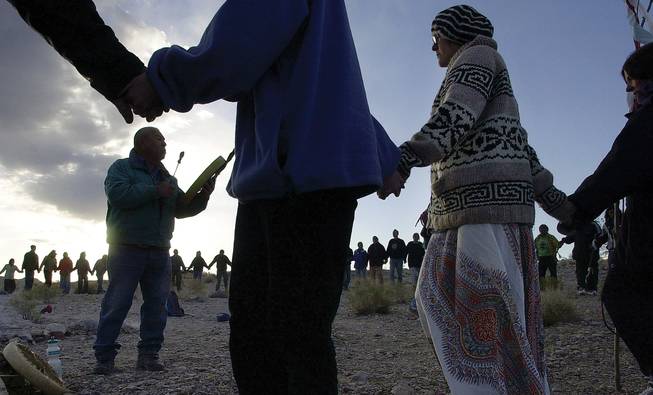
More than 150 years after the first treaty between the Western Shoshone and the federal government was signed, the two nations disagree on the outcome—the Shoshone say they never turned over their land.
The majority of the land in Nevada falls under the Shoshone’s historical claim. It includes the Nevada National Security Site (formerly Nevada Test Site), which has released hundreds of tons of fallout in its operational history. It also includes Yucca Mountain, which has been the center of a decades-long argument centered on the long-term storage of the nation’s nuclear waste.
The plan to turn the mountain into a nuclear waste facility drums up memories of past nuclear use of the land, and some members of the tribe are pushing back.
August 13 Robert Malley, President and CEO of the International Crisis Group, sits down with Joe Cirincione to discuss the current situation in Iran, which he sees as a 21st century ‘Guns of August.’
Robert served in the Obama administration as Special Assistant to the President, Senior Adviser to the President for the Counter-ISIL Campaign, and White House Coordinator for the Middle East, North Africa and the Gulf region. Michelle Dover hosts Early Warning with Ploughshares Fund Deputy Director of Policy Mary Kaszynski and Jessica Sleight, Program Director at Global Zero.
Listen, Subscribe and Share on iTunes · Spotify · SoundCloud · YouTube · Google Play · Sticher
Also available on ploughshares.org/pressthebutton
Church Rock, America’s Forgotten Nuclear Disaster, Is Still Poisoning Navajo Lands 40 Years Later
Residents say they’ve been ignored even as they struggle with contaminated water and worry about having children.
BY SAMUEL GILBERT & RAMSAY DE GIVE | cnn.com
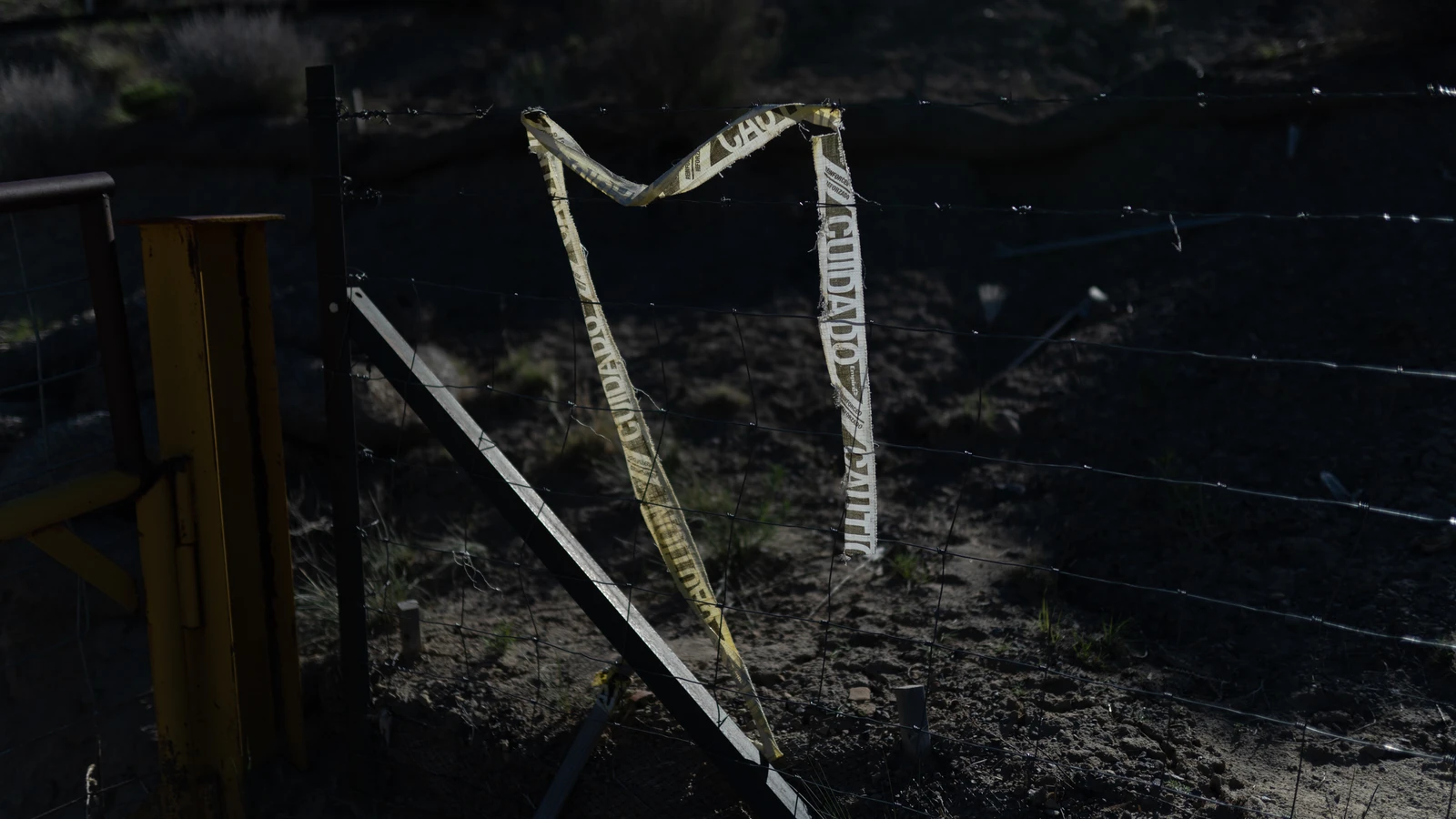
A BARBED-WIRE FENCE IN CHURCH ROCK, NEW MEXICO.
Early in the summer of 1979, Larry King, an underground surveyor at the United Nuclear Corporation’s Church Rock Uranium mine in New Mexico, began noticing something unusual when looking at the south side of the tailings dam. That massive earthen wall was responsible for holding back thousands of tons of toxic water and waste produced by the mine and the nearby mill that extracted uranium from raw ore. And as King saw, there were “fist-sized cracks” developing in that wall. He measured them, reported them to his supervisors, and didn’t think anything more of it.
A few weeks later, at 5:30 a.m. on July 16, 1979, the dam failed, releasing 1,100 tons of uranium waste and 94 million gallons of radioactive water into the Rio Puerco and through Navajo lands, a toxic flood that had devastating consequences on the surrounding area.
“The water, filled with acids from the milling process, twisted a metal culvert in the Puerco,” according to Judy Pasternak’s book Yellow Dirt: A Poisoned Land and the Betrayal of the Navajos. “
Sheep keeled over and died, and crops curdled along the banks. The surge of radiation was detected as far away as Sanders, Arizona, fifty miles downstream.” According to a Nuclear Regulatory Commission report, radioactivity levels in the Puerco near the breached dam were 7,000 times that of what is allowed in drinking water.
See NukeWatch’s 22-page formal comments on expanded plutonium pit production
“Until NNSA fully complies with the National Environmental Policy Act through the preparation of a programmatic environmental impact statement on expanded plutonium pit production, Nuclear Watch believes that any irreversible or irretrievable commitment of resources to either the expansion of pit production at the Los Alamos Lab or to the repurposing of the MOX Facility at the Savannah River Site is unlawful.“
NRDC Comments on NNSA’s Draft SA of 2008 CT PEIS
These comments by the Natural Resources Defense Council (NRDC) reiterate two fundamental points I have already made with co-counsel William N. Lawton of Meyer Glitzenstein & Eubanks, LLP in our May 17, 2019 letter to Department of Energy (DOE) Secretary James Richard Perry and National Nuclear Security Administration (NNSA) Administrator Lisa Gorden-Hagerty
1) Given NNSA’s May 10, 2018 decision to expand plutonium pit production, the National Environmental Policy Act (NEPA) clearly requires the agency to prepare a new programmatic environmental impact statement (PEIS) to supplement the 2008 Complex Transformation PEIS; and
2) Even if NNSA does not agree with the above, there is a 1998 court order that requires DOE to prepare a supplemental PEIS in the event NNSA’s proposed plans for future plutonium pit production extend beyond fabrication at LANL of 50 pits per year under “routine conditions,” or 80 pits per year under “multiple shift operations.”
The Ongoing Call for Nuclear Abolition at Los Alamos
The sick people who prevent gun control and support AK47s are the same people who support the building and maintenance of nuclear weapons, which put millions of people at risk from some unimaginable massacre to come.
AUGUST 9, 2019 | BY REV. JOHN DEAR | commondreams.org
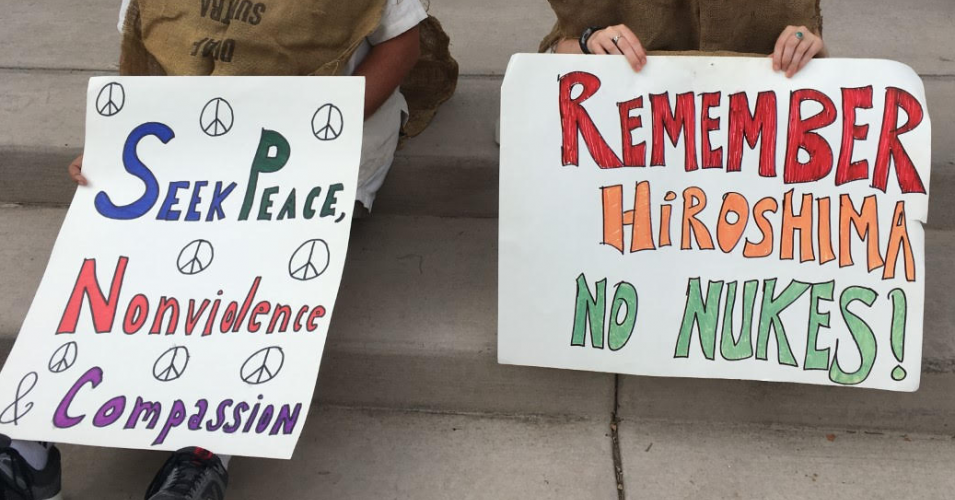
REFLECTING ON THE 74th ANNIVERSARY OF HIROSHIMA
This week, we drove back up the remote New Mexico mountains to the “atomic city” for our annual peace vigil, sit in and rally. This was our 16th year in a row.
Jay Coghlan of NukeWatch New Mexico talked about the seriousness and stupidity of the Trump Administration’s decision last week to pull out of the Arms Control Treaty, a decision that has gotten lost in all the other bad news (see: www.nukewatch.org). Joni Arends of Concerned Citizens for Nuclear Safety New Mexico spoke of the latest shenanigans by the Labs, to bypass the legal oversight of its water purification system so that plutonium contaminated water can continue to poison the land (see: www.nuclearactive.org). Alicia from NukeWatch explained the latest progress with the U.N. treaty to outlaw nuclear weapons, organized by the 2017 Nobel Peace Prize winning group, the International Campaign to Abolish Nuclear Weapons (see: www.icanw.org).
VIEW MORE PHOTOS FROM THE EVENT
Radioactive pollution leaked through floor of South Carolina nuclear fuel plant
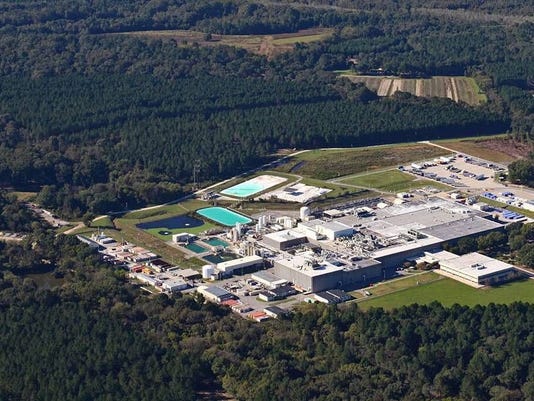
(Photo: Courtesy of High Flyer/The State)
BY SAMMY FRETWELL | greenvilleonline.com
Radioactive uranium has leaked through the floor at Westinghouse’s Bluff Road fuel factory, contaminating the soil in an area of Richland County with a nearly 35-year history of groundwater pollution from the plant.
The U.S. Nuclear Regulatory Commission says the uranium, a toxic substance used to make nuclear fuel rods, seeped through a 3-inch hole in a concrete floor in part of the factory where an acid is used. The hole extends 6 feet into the ground, according to the NRC. The NRC learned of the leak July 12.
Are We Headed for Another Expensive Nuclear Arms Race? Could Be.
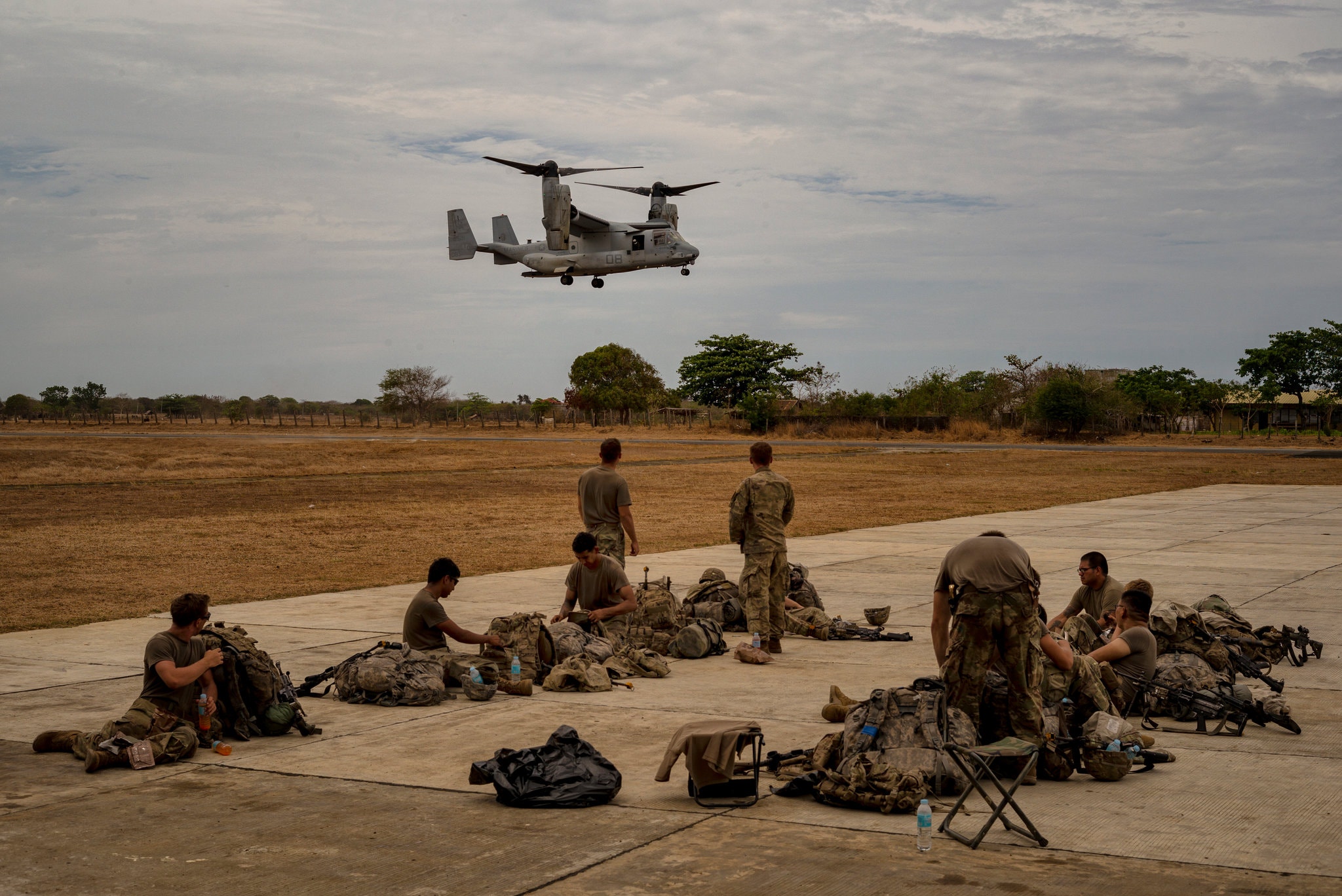
BY STEVEN ERLANGER | nytimes.com
BRUSSELS — After the recent death of the treaty covering intermediate-range missiles, a new arms race appears to be taking shape, drawing in more players, more money and more weapons at a time of increased global instability and anxiety about nuclear proliferation.
The arms control architecture of the Cold War, involving tens of thousands of nuclear weapons, was laboriously designed over years of hard-fought negotiations between two superpowers — the United States and the Soviet Union. The elaborate treaties helped keep the world from nuclear annihilation.
Pakistan downgrades diplomatic ties, suspends trade with India over Kashmir
Kashmir in lockdown as India plans to change state’s status
BY JESSIE YEUNG & SOPHIA SAIFI | cnn.com
Islamabad, Pakistan (CNN) Pakistan has announced it will downgrade diplomatic relations and suspend bilateral trade with India after New Delhi stripped the disputed state of Jammu and Kashmir of its special status. India’s High Commissioner will also be removed from the country, Pakistan’s Ministry of Foreign Affairs said in a statement Wednesday. It added that Islamabad will not send its own ambassador to New Delhi.
The series of announcements came after a National Security Committee meeting on Wednesday, where the office of Pakistan’s Prime Minister Imran Khan said that Islamabad would also review bilateral agreements with India and take the issue up with the United Nations and the UN Security Council.
TPNW is now officially halfway towards entry into force!
On August 6th, 1945 at 8:16 am, a nuclear bomb was dropped on the city of Hiroshima, killing over 140,000 people and wiping out most of the city. 74 years later, the bomb’s catastrophic consequences are still affecting people’s lives.

Today, tens of thousands of people have gathered in Hiroshima, and around the world, to commemorate the victims and echo the call of the Hibakusha – the survivors of the bombings of Hiroshima and Nagasaki – that such a thing must never happen again. And at the UN in New York, one such commemoration took a very special form today: Bolivia has just marked Hiroshima Day by depositing its ratification instrument for the UN Treaty on the Prohibition of Nuclear Weapons (TPNW). With this ratification, TPNW is now officially halfway towards entry into force!
Read more about this special moment
The Human Cost of the Hiroshima Bombing
PODCAST: Listen to the story of Kathleen Burkinshaw, the daughter of a survivor of the Hiroshima bombing. Kathleen reminds us that she and her mother are among the tens of thousands of people who view nuclear weapons in terms of the friends and family members they lost.
? New Podcast Alert ?: in memory of the 74th anniversary of the bombing of Hiroshima, Nukes of Hazard podcast host @NuclearWilson sat down with @klburkinshaw1, daughter of a #Hiroshima survivor, to discuss the human cost of the bombing. Listen here: https://t.co/iNs05KkbXc pic.twitter.com/YHm6py7Fnr
— Nukes of Hazard (@nukes_of_hazard) August 6, 2019
“For this week’s Press the Button, we mark the 74th anniversary of the Hiroshima bombing with a special edition episode.”
Listen and subscribe to Press the Button, a weekly podcast from Ploughshares Fund dedicated to nuclear policy and national security.
August 6th — Two interrelated issues are discussed: Should US policy today still reserve the right to use nuclear weapons first, and what happened when we did go first nearly three quarters of a century ago?
“To help answer these questions, we bring you the very best from a multitude of our earlier interviews. You’ll hear from nuclear historian Alex Wellerstein, former Obama deputy national security advisor Ben Rhodes, former RAND analyst and releaser of the Pentagon Papers Daniel Ellsberg, founding director of the Consortium on Gender, Security and Human Rights Carol Cohn, and Beatrice Fihn, executive director of the Nobel Peace Prize-winning International Campaign to Abolish Nuclear Weapons (ICAN).
Also featuring special guest Kingston Reif from the Arms Control Association, to discuss recent nuclear news on the Early Warning segment. Kingston talks about the INF Treaty withdrawal, no-first-use, and the latest from Iran..
Listen, Subscribe and Share on iTunes · Spotify · SoundCloud · Google Play
Also available on ploughshares.org/pressthebutton
The Democratic Debates Need More Questions About Nuclear War
There is a remarkable incongruity between the existential danger of nuclear war and the absence of public discussion about preventing it. This disconnect is all too apparent today, as arms control and disarmament treaties are scrapped, nations embark on vast nuclear weapons buildups, and governments threaten nuclear war against one another.

SCOTT OLSON / GETTY IMAGES
BY LAWRENCE WITTNER |truthout.org
Meanwhile, the mass media routinely avoids these issues but, instead, focuses on movie stars, athletes, and President Donald Trump’s latest tweeted insults.
Do I exaggerate? Consider the following.
In May 2018, the Trump administration unilaterally withdrew from the laboriously constructed Iran nuclear agreement that had closed off the possibility of that nation developing nuclear weapons. The U.S. pullout was followed by the imposition of heavy U.S. economic sanctions on Iran, as well as by thinly veiled threats by Trump to use nuclear weapons to destroy that country. Irate at these moves, the Iranian government recently retaliated by exceeding the limits set by the shattered agreement on its uranium stockpile and uranium enrichment.
NNSA Weighing Whether Nuke Parts Delays Could Prevent Timely Deployment
EXCHANGE MONITOR | exchangemonitor.com
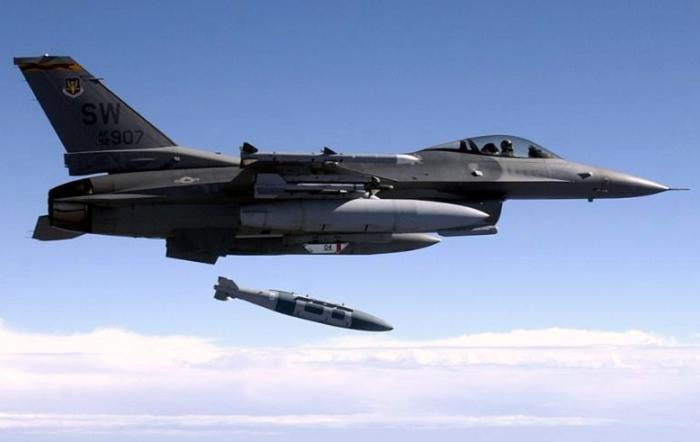
The National Nuclear Security Administration (NNSA) is still determining if problems with non-nuclear components will prevent the B61-12 gravity bomb and W88 Alt 370 submarine-launched ballistic missile warhead from entering service with the Air Force and Navy.
Arms Control Association – Statement on U.S. Withdrawal from the INF Treaty
“The loss of the landmark INF Treaty, which helped end the Cold War nuclear arms race, is a blow to international peace and security.”
Statement from Daryl G. Kimball, executive director | armscontrol.org | Media Contacts: Daryl G. Kimball, executive director, 202-463-8270 ext. 107; Kingston Reif, director for disarmament policy, 202-463-8270 ext. 104
“Russian noncompliance with the INF Treaty is unacceptable and merits a strong response. But President Trump’s decision to terminate the treaty will not eliminate Russia’s noncompliant 9M729 missiles — and is a mistake.
“Worst of all, blowing up the INF Treaty with no substitute arms control plan in place could open the door to a dangerous new era of unconstrained military competition with Russia.
Communities in the American Southwest Were Exposed to Nuclear Fallout. Can They Get Compensated?
Radiation epidemiology is a science of uncertainty.
BY: ARIA ALAMALHODAEI | motherjones.com
The atomic bomb was born in the desert. In the early hours of July 16, 1945, after a spate of bad weather, a 20-kiloton plutonium-based nuke referred to as “the gadget” detonated near Alamogordo, New Mexico. Firsthand testimonies of the test, codenamed Trinity, converge on the uncanny axis of awe and dread.
The Manhattan Project’s Chief of Field Operations, General Thomas Farrell, wrote that “the strong, sustained, awesome roar…warned of doomsday and made us feel that we puny things were blasphemous.”
The bomb produced a massive cloud column that drifted in several directions, dusting large swaths of the surrounding region with radioactive snow—fallout that settled on buildings, plants, and animals, and that continued to permeate the air as invisible particulate in the weeks and months that followed. Five years later, the Nevada Test Site was established to continue the work that Trinity set alight.
Although the mushroom cloud became the icon of American nuclear activity in the 20th century, the harms of these bombs did not fade with their dimming fireballs. No group in the US understands this better than the downwinders, communities throughout the American Southwest and beyond who were exposed to the fallout of the military’s domestic nuclear test program.
The INF Treaty Officially Died Today
Six months after both the United States and Russia announced suspensions of their respective obligations under the Intermediate-Range Nuclear Forces Treaty (INF), the treaty officially died today.
Federation of American Scientists | Posted on Aug.02, 2019 in Arms Control, Nuclear Weapons, Russia, United States by Hans M. Kristensen & Matt Korda
The Federation of American Scientists strongly condemns the irresponsible acts by the Russian and US administrations that have resulted in the demise of this historic and important agreement.
In a they-did-it statement on the State Department’s web site, Secretary of State Michael Pompeo repeated the accusation that Russia has violated the treaty by testing and deploying a ground-launched cruise missile with a range prohibited by the treaty.
“The United States will not remain party [sic] to a treaty that is deliberately violated by Russia,” he said.
By withdrawing from the INF, the Trump administration has surrendered legal and political pressure on Russia to return to compliance. Instead of diplomacy, the administration appears intent on ramping up military pressure by developing its own INF missiles.

Today, 2 August 2019, the governments of the US and Russia have missed a troubling deadline: the end of the six-month notice period that began when both countries announced their withdrawal from the INF Treaty earlier this year. During this period, the decision could still be reversed if both parties went back to the negotiating table. Now that the deadline has passed, and both states can produce even more nuclear weapons, this time enabled to hit targets in the range of 500 and 5,500 kilometres. These weapons, optimised to destroy cities and wipe out civilian populations, put the whole world – and Europe in particular – at risk.
A nuclear treaty is about to vanish. Its demise should teach a lesson.
On Friday, a pillar of global security will expire.
BY EDITORIAL BOARD | washingtonpost.com
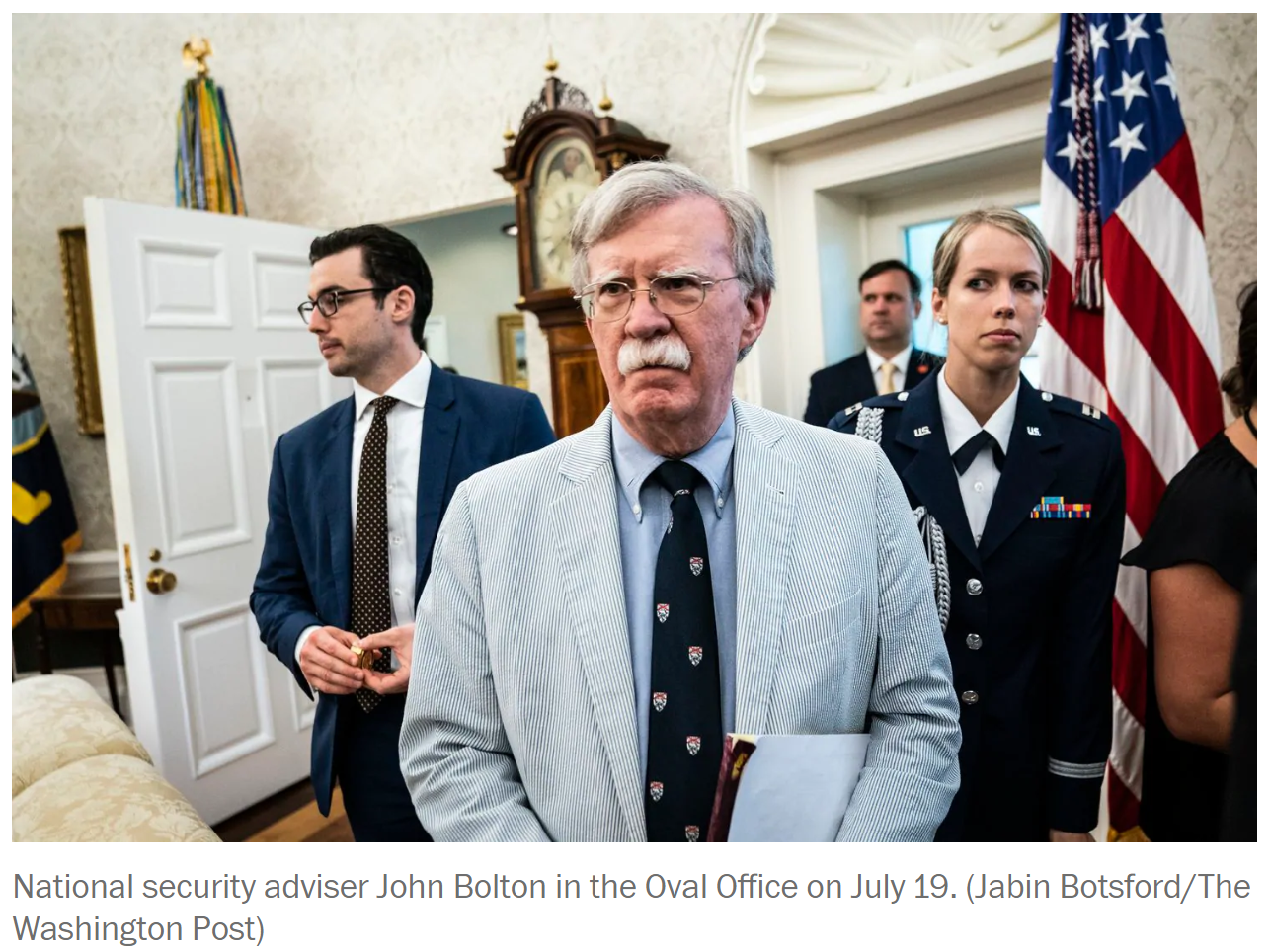 Perhaps no one will notice when the Intermediate-range Nuclear Forces Treaty of 1987 slips into oblivion; the threat of nuclear attack in just minutes that seemed so unnerving during the late 20th century has now faded into a distant memory, lost to complacency at the Cold War’s end. But the demise of the INF Treaty should teach a lesson.
Perhaps no one will notice when the Intermediate-range Nuclear Forces Treaty of 1987 slips into oblivion; the threat of nuclear attack in just minutes that seemed so unnerving during the late 20th century has now faded into a distant memory, lost to complacency at the Cold War’s end. But the demise of the INF Treaty should teach a lesson.
Arms control, creating verifiable treaties to limit and reduce nuclear, chemical and biological weapons, had its mystique: obtuse concepts, exotic hardware and mind-bending negotiations. But at its core, arms control was about political willpower. In the case of the INF Treaty, President Ronald Reagan and Soviet leader Mikhail Gorbachev summoned enough of it to eliminate an entire class of deployed weapons, the ground-based missiles with a range of between 300 and 3,400 miles, and their launchers. The treaty made the world safer not only by removing a nuclear threat to Europe but also by introducing novel measures such as intrusive verification and on-site inspections.
If New START Dies, These Questions Will Need Answers
There’s little public indication that the Trump administration is thinking about several things that will happen if the last strategic arms agreement is allowed to expire.
BY VINCENT MANZO & MADISON ESTES | defenseone.com
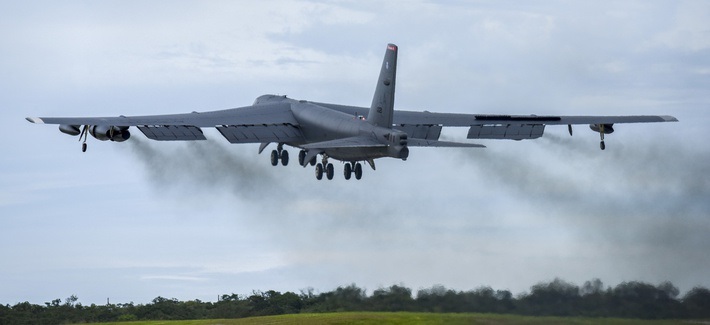
A U.S. Air Force B-52H Stratofortress bomber takes off from Andersen Air Force Base, Guam, for a routine training mission in the vicinity of the South China Sea and Indian Ocean, Sept 23, 2018.
The Trump administration has articulated an ambitious new vision for nuclear arms control, one that includes China and seeks to limit more types of Russian systems. This vision appears to have little room for the New START agreement, which helped to cap U.S. and Russian nuclear arsenals and which is due to expire in 2021. And yet there is little in the public record to indicate how the administration would deal with various problems that would surface if New START is left to die.
Did Trump Just Threaten to Attack Iran With Nukes?
He said he could destroy Afghanistan but was signaling elsewhere. The scary part is there’s already a plan.
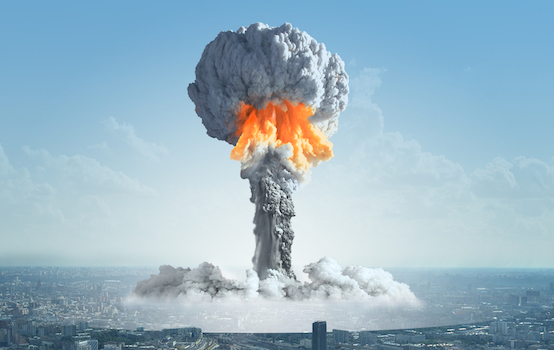
BY SCOTT RITTER | theamericanconservative.com July 25, 2019
On Monday during a press conference between Donald Trump and Pakistani Prime Minister Imran Khan, Trump spoke rather casually of having reviewed plans to annihilate Afghanistan.
“I could win that war in a week. I just don’t want to kill 10 million people,” Trump said. “I have plans on Afghanistan that if I wanted to win that war, Afghanistan would be wiped off the face of the earth, it would be gone. It would be over in, literally, in 10 days. And I don’t want to go that route.”
Trump’s seemingly blasé reference to a hypothetical mass murder on a scope and scale never seen in the history of mankind (it took Nazi Germany more than four years to kill six million Jews) was stunning. We know, given the state of play in Afghanistan, that it will never happen. But it wasn’t offhand. Such a policy of total destruction could also be seen as applying to Iran, and the potential for the use of nuclear weapons in the event of a U.S.-Iranian conflict is far from hypothetical. He knew exactly what he was doing.
Continue reading
As we mark the seventy-fourth anniversary of the Hiroshima and Nagasaki bombings in a handful of days, we will rightly remember the horrors of nuclear war.
BY ZACK BROWN & ALEX SPIRE
For a brief fraction of a second on an early March morning in 1954, the United States summoned a second sun into existence above Bikini Atoll.
As the four-mile wide fireball bathed the Pacific seascape in its angry, white-red light, onlookers recognized something nearly divine—and unquestionably ominous. “It was a religious experience, a personal view of the apocalypse or transfiguration,” said one observer. Another remembered feeling “like you stepped into a blast furnace,” even though he was over thirty miles away.
This was the Castle Bravo thermonuclear test, one of several dozen nuclear detonations the United States carried out in the Marshall Islands during the Cold War. At 15 million tons of TNT—one thousand times more powerful than the bomb that destroyed Hiroshima—it was the largest explosion ever set off by Americans.
Yukiya Amano, Head of the I.A.E.A. Nuclear Watchdog Group, Dies at 72
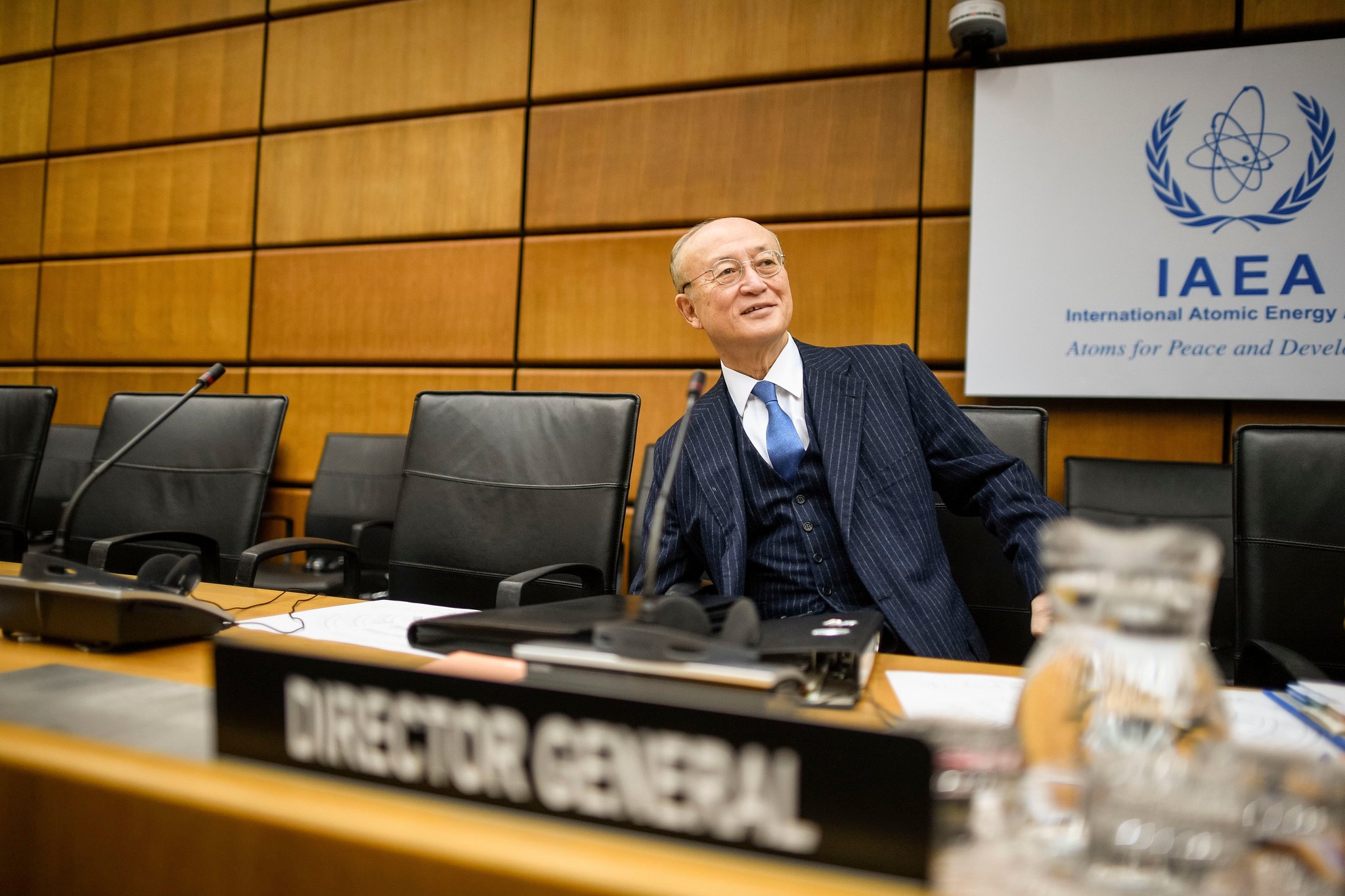
BY MEGAN SPECIA & DAVID E. SANGER | nytimes.com July 22, 2019
Yukiya Amano, a Japanese diplomat who played a central role in inspecting Iran’s compliance with the landmark 2015 nuclear deal as the head of the International Atomic Energy Agency in Vienna, has died, the organization announced on Monday. He was 72.
The agency, part of the United Nations, did not cite a cause of death or say when and where he died, but word had begun to spread last week that Mr. Amano had planned to step down from his position as director-general after nearly a decade because of an unspecified illness. He was two years into a third term as the agency’s leader.
His death left the agency leaderless at a critical moment: just as Iran is edging away from the nuclear agreement and beginning carefully calibrated violations of the limits on how much nuclear material it can produce, and at what level of purity.
Inside the Secret Campaign to Export U.S. Nuclear Tech to Saudi Arabia
Industry coalition’s push to win over the Trump administration is concerning officials on Capitol Hill who are fearful that it could threaten U.S. national security.

ERIN BANCO | thedailybeast.com
When President Donald Trump took the stage in the East Room of the White House earlier this month to give his first speech on the environment, nuclear energy executives and industry leaders held their breath. They exchanged text messages with fellow colleagues during the speech’s broadcast, wondering aloud to one another if Trump had taken the bait.
Since the fall of 2016, the executives have built an underground coalition along with academics, technology experts and well-connected politicos, including some lobbyists, to get the president and his administration to support—even promote—an American nuclear energy comeback. The industry has declined in recent years due mostly to the closing of critical nuclear infrastructure and plants. Between 2010 and 2018, only one new nuclear power plant came online in the United States.
Thank you to those who submitted comments in the NNSA’s EIS “scoping” for the proposed Plutonium Bomb Plant (PBP) at the Savannah River Site. The PBP remains unauthorized and unfunded.
“Despite requests by many, NNSA denied extending the comment period. Though the comment period ended on July 25, there is still time to submit late comments. (See Federal Register notice of June 10.)
Special thanks are due to the experts at Nuclear Watch New Mexico, Tri-Valley CAREs and the Oak Ridge Environmental Peace Alliance (OREPA) for submitting extensive comments pertaining to the question of “need” for new pits for new nuclear weapons.
It is of note that we enlisted groups that don’t traditionally work on nuclear weapons or DOE issues to engage the scoping process, including the South Carolina Chapter of the Sierra Club, Conservation Voters of South Carolina and the League of Women Voters of South Carolina. Plus, there were a flurry of individual comments in the last few days.
Comments included the lack of need for new pits for the W87-1-style warhead, the issue of pit reuse and the need for a “nuclear non-proliferation risk assessment” on the production of new pits for new nuclear weapons.
Sheep Fire Burns on Idaho National Laboratory Land
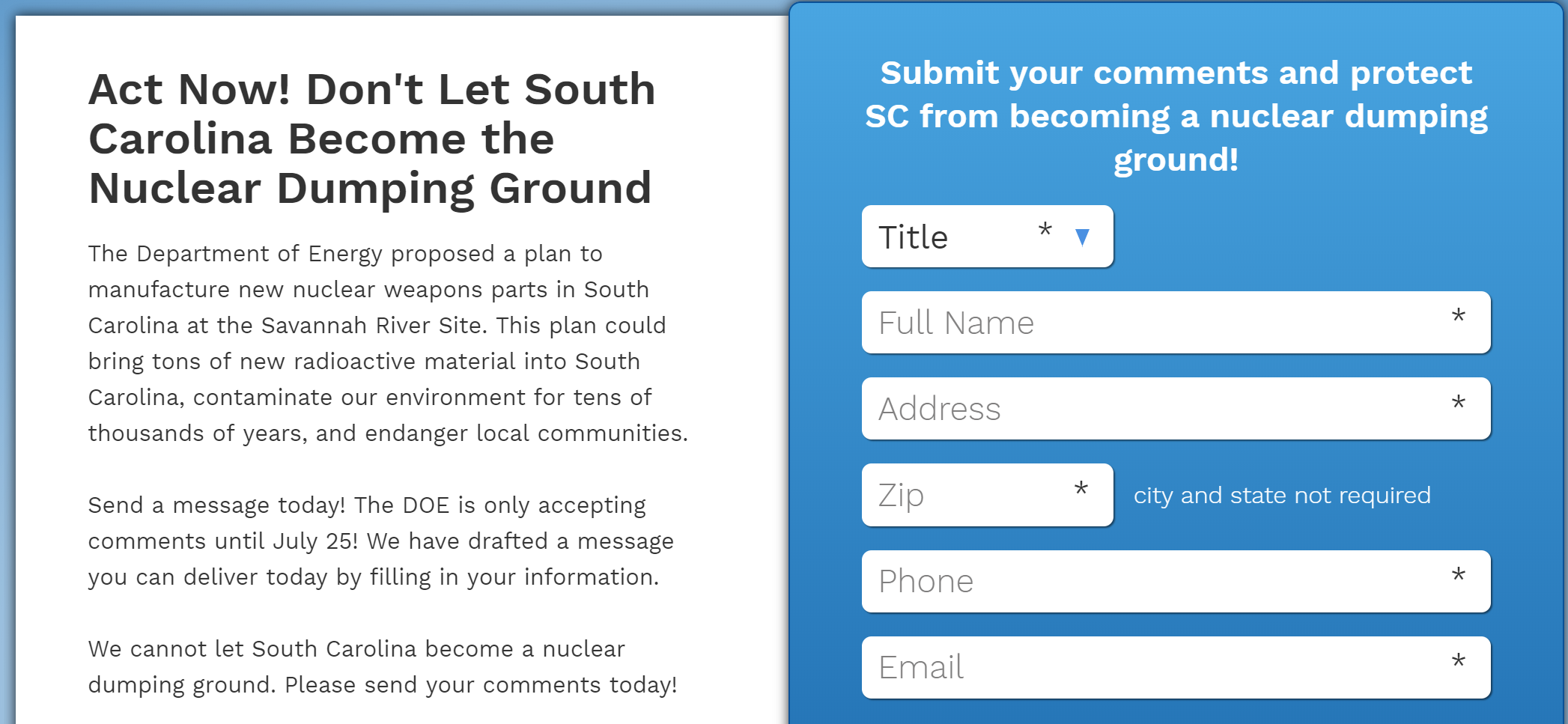
Listen and subscribe to Press the Button, a weekly podcast from Ploughshares Fund dedicated to nuclear policy and national security.
July 22 — This episode features Alex Wellerstein, historian of science at the Stevens Institute of Technology and creator of NUKEMAP – a website that allows you to simulate the effects of a nuclear weapons anywhere in the world. He talks in depth about the decision to drop the Bomb on Hiroshima and Nagasaki, on the effectiveness of nuclear deterrence, on the debate about the Bomb’s use after Trinity and much more.
Also featuring a guest appearance by WAND’s Caroline Dorminey.
Listen, Subscribe and Share on iTunes · Spotify · SoundCloud · Google Play
Also available on ploughshares.org/pressthebutton
In Budget Deal, White House And Congress Overpay For The Pentagon
The newly proposed two-year budget deal between the White House and Congress has one major flaw. It vastly overpays for the Pentagon.
At $738 billion for Fiscal Year 2020 and $740 billion for Fiscal Year 2021, the agreement sets the table for two of the highest budgets for the Pentagon and related work on nuclear warheads at the Department of Energy since World War II. The proposed figures are higher than spending at the height of the Vietnam and Korean Wars, and substantially more than the high point of the Reagan buildup of the 1980s. And the Fiscal Year 2020 and Fiscal Year 2021 numbers are only slightly less than spending in 2010, when the United States had 180,000 troops in Iraq and Afghanistan, roughly nine times the number currently deployed.
A Path Toward Renewing Arms Control
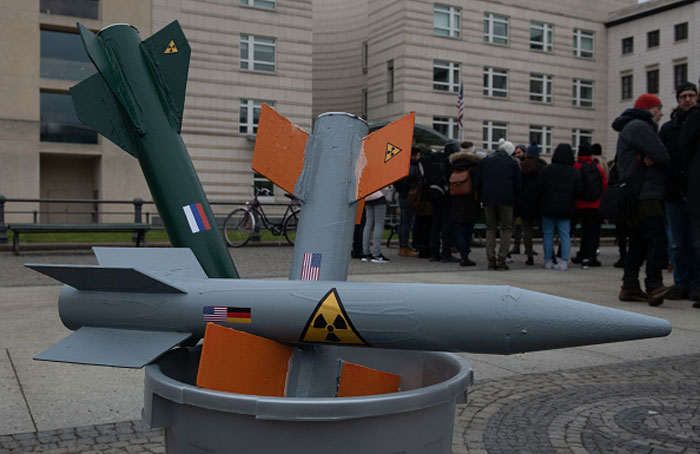
LAWRENCE J. KORB | thebulletin.org
At the late June G-20 meeting in Osaka, Japan, US President Trump and Russian President Putin met to discuss a number of issues, including Iran, Syria, Venezuela, Ukraine, and arms control. While all of these are important, none is more urgent at the current time than arms control because we are on the brink of a new arms race that could be an existential threat not only to these two nuclear super powers but to humanity.
Fewer Inspections for Aging Nuclear Plants, Regulators Propose
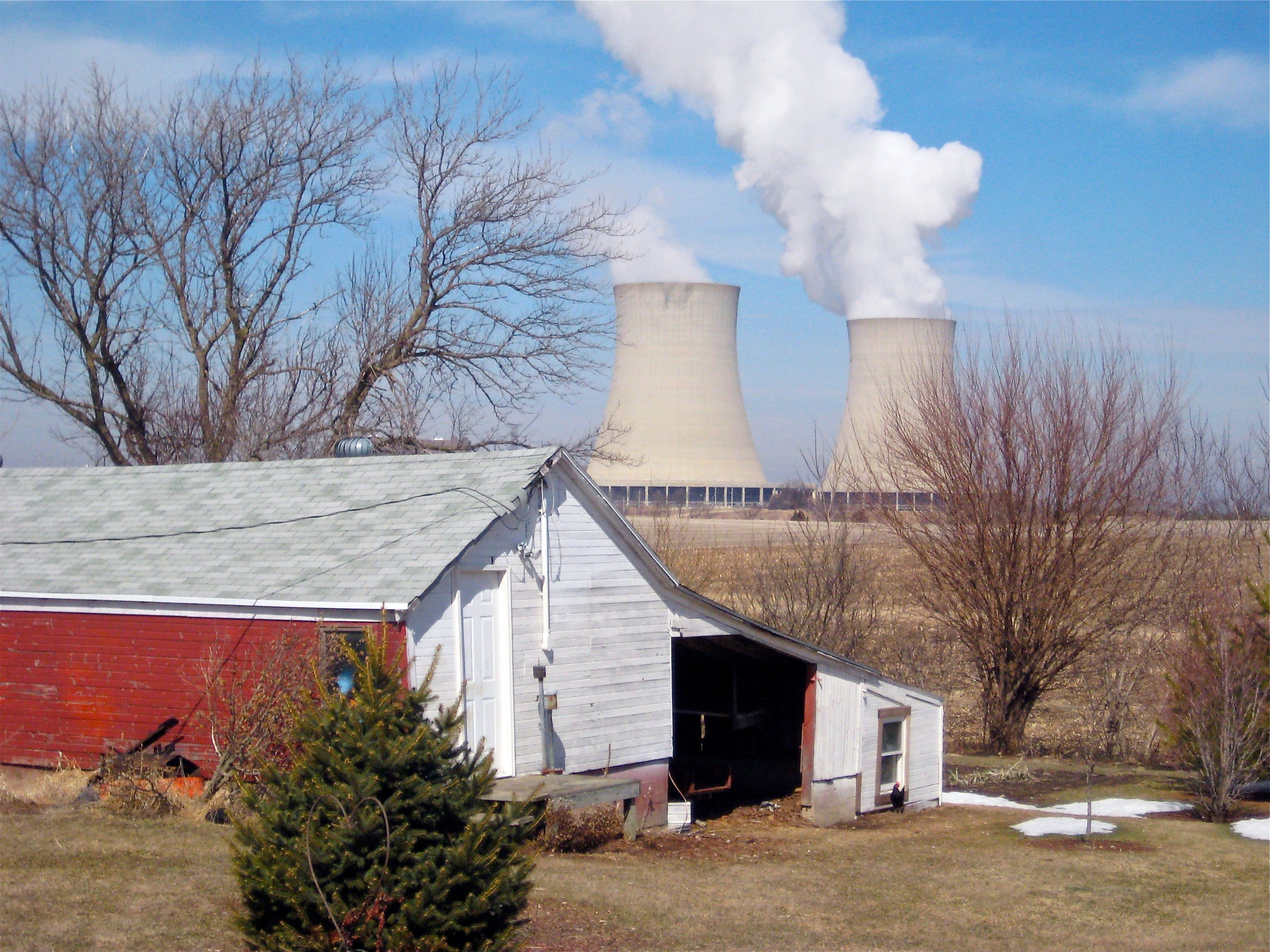
BY CORAL DAVENPORT | nytimes.com
WASHINGTON — A new report by staff members of the Nuclear Regulatory Commission, which oversees the safety of the nation’s 59 aging nuclear power plants, recommends that the commissioners significantly weaken or reduce safety inspections of the plants.
Edwin Lyman, the acting director of nuclear safety programs for the Union of Concerned Scientists, was highly critical of the proposal. “That’s bad because it could impair the ability of the N.R.C. to see larger patterns of violations at a plant,” he said, and called the proposal “a PR stunt. They’re doing it to make these things sound better.”
The report, published Tuesday, comes after a yearlong consultation and public meeting process, including views from the Nuclear Energy Institute, which lobbies on behalf of the nuclear power plant industry and has long sought weaker safety rules. It also comes amid a broader push by the Trump administration for reduced regulations on industry.
When Radioactive Wastes Aren’t Radioactive Wastes
With Congress Limiting What Can Be Dumped at Nuke Sites, the Energy Department May Just Redefine What It’s Dumping
JILLIAN S. AMBROZ. | dcreport.org
The U.S. Department of Energy wants to redefine what constitutes high-level radioactive waste, cutting corners on the disposal of some of the most dangerous and long-lasting waste byproduct on earth—reprocessed spent fuel from the nuclear defense program.
The agency announced in October 2018 plans for its reinterpretation of high-level radioactive waste (HLW), as defined in the Nuclear Waste Policy Act (NWPA) of 1982, with plans to classify waste by its hazard level and not its origin. By using the idea of a reinterpretation of a definition, the DOE may be able to circumvent Congressional oversight. And in its regulatory filing, the DOE, citing the NWPA and Atomic Energy Act of 1954, said it has the authority to “interpret” what materials are classified as high-level waste based on their radiological characteristics. That is not quite true, as Congress specifically defined high-level radioactive waste in the Nuclear Waste Policy Act, and any reinterpretation of that definition should trigger a Congressional response.
Lawmaker: Expand compensation from nuclear weapons testing
Original Article: apnews.com | BY SUSAN MONTOYA BRYAN
ALBUQUERQUE, N.M. (AP) — A compensation program for those exposed to radiation from years of nuclear weapons testing and uranium mining would be expanded under legislation that seeks to address fallout across the western United States, Guam and the Northern Mariana Islands.
U.S. Rep. Ben Ray Lujan rolled out the measure Tuesday on the 74th anniversary of the Trinity Test.
As part of the top-secret Manhattan Project, government scientists and the U.S. military dropped the first atomic bomb in the New Mexico desert in 1945. Nearly 200 atmospheric tests followed. Uranium mining persisted even after the tests ceased.
The Pentagon has more money than it can spend. Both Democrats and the GOP are to blame.
“To save taxpayer money and increase U.S. national security, the first step must be to reconceptualize U.S. strategy. That means abandoning the military-first approach that has governed U.S. security policy during this century.”
ARTICLE BY BEN FREEMAN & WILLIAM D. HARTUNG | newsweek.com
The bid from the Republican controlled Senate is $750 billion. The just passed bid from the Democratic controlled House is $733 billion. Both have radically overbid on the price of the Pentagon.
The real cost of the prize that is America’s security is significantly lower than what either party is currently bidding. As the Sustainable Defense Task Force—a group of ex-military officers, former White House and Congressional budget experts, and non-governmental analysts convened by the Center for International Policy which we co-chair—has found, America can be made more secure through less, not more, Pentagon spending. This is possible by rethinking U.S. defense strategy, taking a sober and fact-based assessment of the enormous amount of money already flowing to the Pentagon, and rigorously cutting waste and inefficiencies from the Pentagon bureaucracy.
Listen and subscribe to Press the Button, a weekly podcast from Ploughshares Fund dedicated to nuclear policy and national security.
July 15 — In this episode, Michelle Dover, Abigail Stowe-Thurston and Tom Collina deliver a wonderful, incisive news segment summarizing the major gains and debates in the NDAA (and how the Kardashians are getting involved in nuclear issues!).
Suzanne DiMaggio is featured delving deep into the dynamics of the crises with Iran and North Korea. Suzanne also presents her powerful rationale for the new Quincy Institute, where she is chair of the board.
“Looking at the catastrophic failures in foreign policy over the past decades, it is clearly time for something new,” Suzanne says, “The times demand it…We have to change the narrative in this town.”
Listen, Subscribe and Share on iTunes · Spotify · SoundCloud · Google Play
Also available on ploughshares.org/pressthebutton
Zakaria: The cancerous consensus in today’s politicized Washington
The United States’ defense budget is out of control, lacking strategic coherence, utterly mismanaged, ruinously wasteful and yet eternally expanding… “We never expected to pass [a financial audit],” admitted then-Deputy Defense Secretary Patrick Shanahan.
BY FAREED ZAKARAIA | trib.com
You often hear that in these polarized times, Republicans and Democrats are deadlocked on almost everything. But the real scandal is what both sides agree on. The best example of this might be the defense budget. Last week, the Democratic House, which Republicans say is filled with radicals, voted to appropriate $733 billion for 2020 defense spending. The Republicans are outraged because they — along with President Trump — want that number to be $750 billion. In other words, on the largest item of discretionary spending in the federal budget, accounting for more than half of the total, Democrats and Republicans are divided by 2.3 percent. That is the cancerous consensus in Washington today.
America’s defense budget is out of control, lacking strategic coherence, utterly mismanaged, ruinously wasteful and yet eternally expanding.
Nuclear News Archives – 2021
Nothing Found
It seems we can’t find what you’re looking for. Perhaps searching can help.


